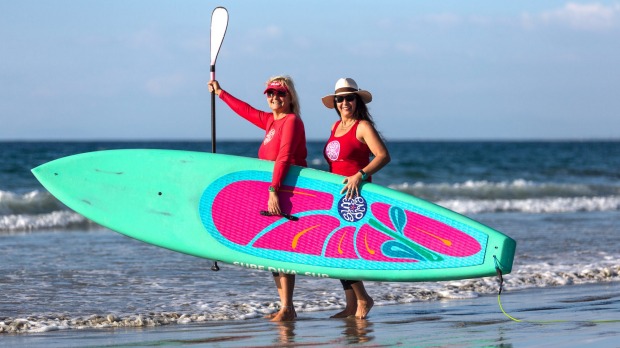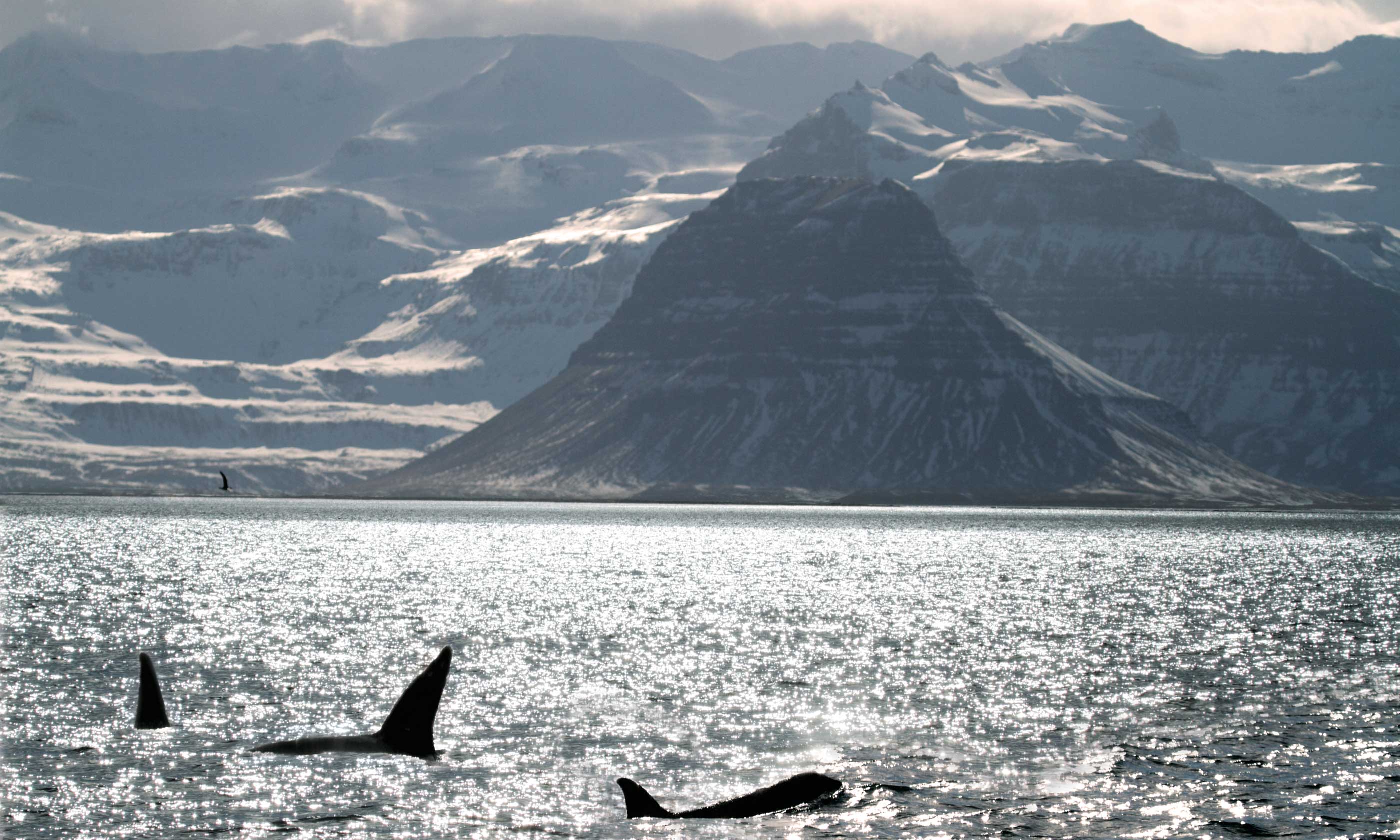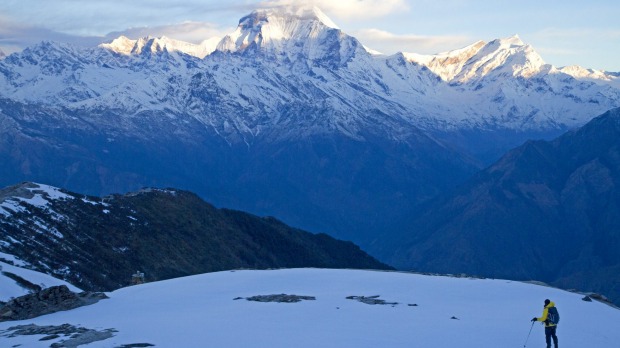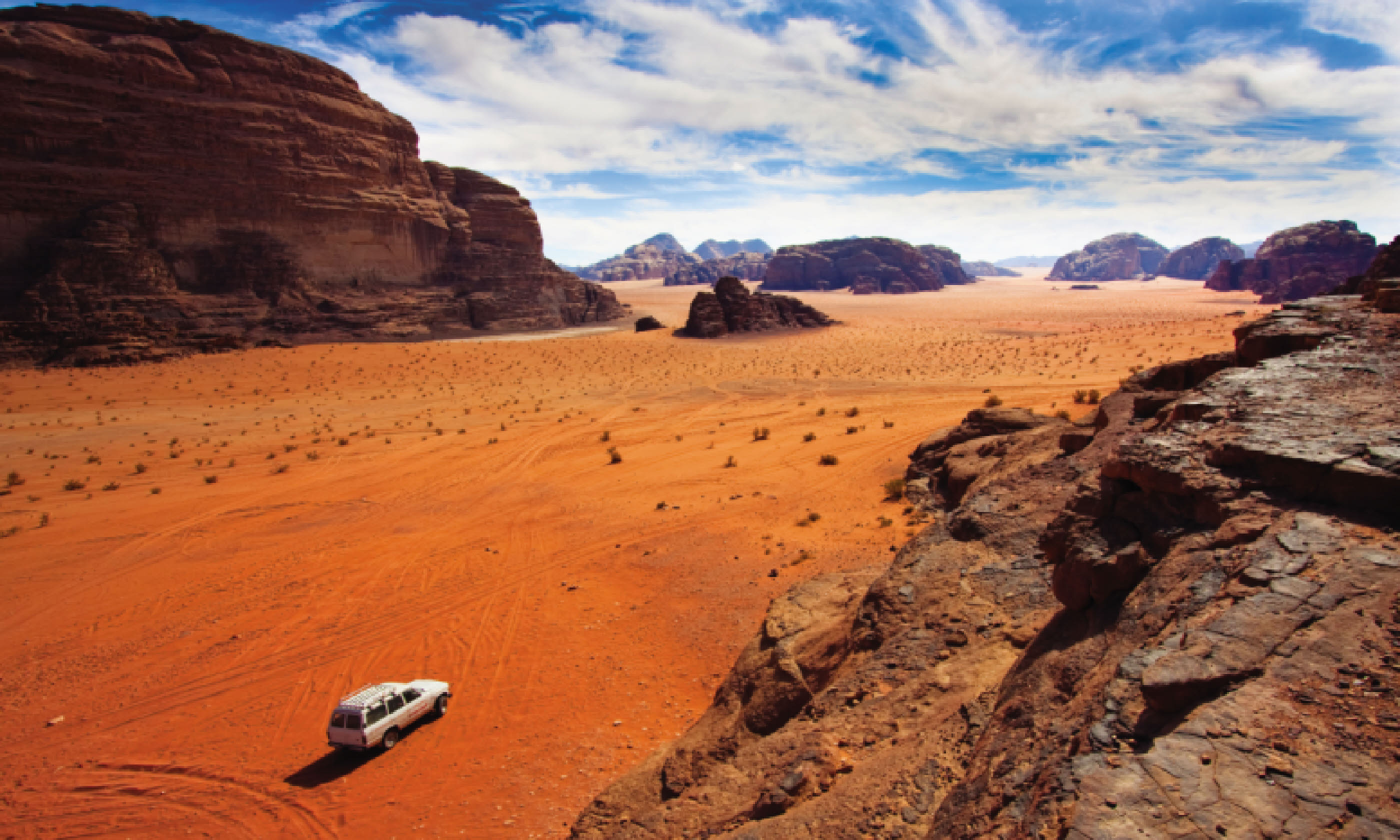
Over the years, you've told us your ultimate travel experiences – so here it is, the definitive travel wish list...
 Get your hands on our new 100 Greatest Travel Experiences book: free with every 2016 Christmas gift subscription to Wanderlust! The perfect gift for travel lovers – and you can even keep the book if you wish (We won't tell!) Sign up here
Get your hands on our new 100 Greatest Travel Experiences book: free with every 2016 Christmas gift subscription to Wanderlust! The perfect gift for travel lovers – and you can even keep the book if you wish (We won't tell!) Sign up here
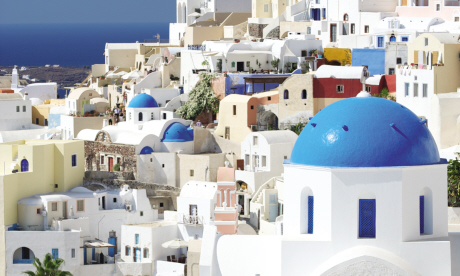 100. Soak up Santorini, Greece
100. Soak up Santorini, Greece This mini-archipelago in the Cyclades was once a huge volcano, but a super-eruption around 1640BC saw it sink into the sea, leaving only remnants of its craggy caldera to be lapped by the Med. The result is pure Greek-isle fantasy: white-washed houses, steep-stepped alleys leading to old harbours, and traditional tavernas serving fish suppers.
Make it happen: Ferries connect Santorini’s island of Thira with other islands, including Crete (5hrs), Mykonos (2.5hrs) and Rhodes (16hrs). Santorini also has an airport.
Get more info on Santorini: Avoid the crowds on Wanderlust's favourite Greek islands
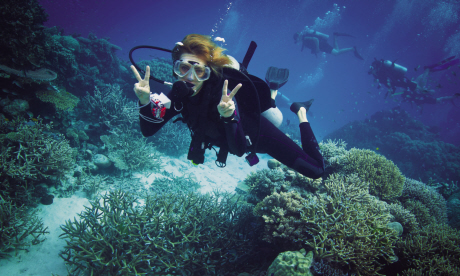 99. Dive the Great Barrier Reef, Australia
99. Dive the Great Barrier Reef, Australia2,600km of coral hugging Australia’s east coast, from Bundaberg in the south to beyond Cape York. Simply, the biggest reef in the world. It has options for all: novice divers can learn in safe waters, yet still see plenty of the reef’s 1,500 fish species during lessons. More experienced divers should sail to the Outer Reef for pristine coral gardens.
Make it happen: Key hubs for diving trips out to the reef include Port Douglas, Cairns, the Whitsunday Islands and Airlie Beach.
Get more info on the Great Barrier Reef: Wanderlust's complete guide to the Great Barrier Reef | Great Barrier Reef's top 10 secrets
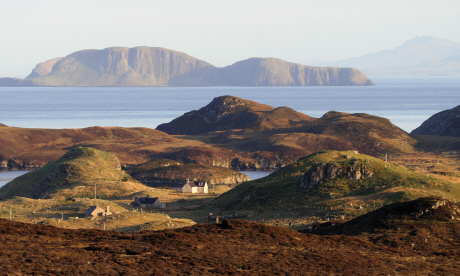 98. Roam the Outer Hebrides, Scotland
98. Roam the Outer Hebrides, ScotlandRinged by some of the UK’s loveliest white-sand beaches and crystal-clear waters, these islands are a mecca for marine wildlife, with whales, dolphins, porpoises and basking sharks visiting year-round. Hikers and bikers will find trails galore, or you could take to the skies and kitesurf over Barra’s beach airstrip, the only one in the UK.
Make it happen: Buy a rover ticket and island-hop on the Caledonian MacBrayne ferry. Avoid June - August to dodge the dreaded Highland midges.
Get more info on the Outer Hebrides: How many of Wanderlust's top 5 activities will you try?
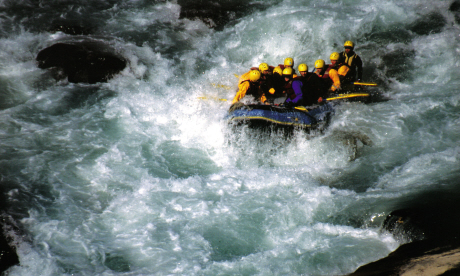 97. Whitewater rafting, Nepal
97. Whitewater rafting, NepalNepal is a-froth with rapids that offer access to glorious gorges and riverbank camps impossible to reach by other means. The Trisuli River is near Kathmandu, ideal for the time-poor, while the Kali Gandaki, nearer Pokhara, is wilder with fine peak views. For a frontier feel, head out west to the Karnali: expeditions offer tough rapids.
Make it happen: Rivers are dangerous at the height of the monsoon (Jul-Aug); the best time is Oct-Nov, when water is fast but manageable.
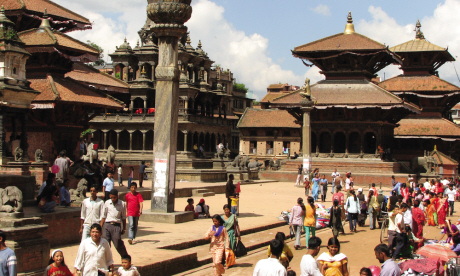 96. Explore the backstreets of Kathmandu, Nepal
96. Explore the backstreets of Kathmandu, NepalStart amid the tiered-roof temples of Durbar Square – former seat of the country’s monarchy, and the old city’s heart – before plunging off-piste, down alleys where dogs are decorated with marigolds, dim shrines flicker with butter lamps, prayer wheels spin, shops sell wool carpets and Gore-Tex jackets.
Get more info on Kathmandu: How to spend your first 24 hours in Kathmandu
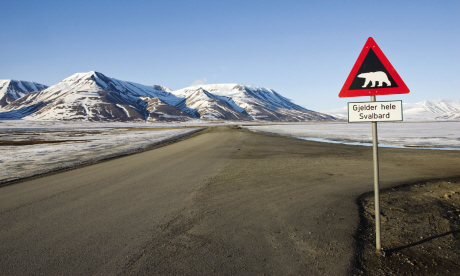 95. Spot polar bears in Spitsbergen, Norway
95. Spot polar bears in Spitsbergen, NorwayThe island of Spitsbergen is home to the northernmost settlements on earth, thanks to the moderating influence of the Gulf Stream. But there are more polar bears (around 3,000) than humans (2,700), which is what makes it so attractive to travellers, most of whom spy a bear on the shores or floes.
Make it happen: Fly into Longyearbyen. Either take an expedition cruise (summer),
or stay on the iced-in schooner Noorderlicht (winter).
Get more info on Spitsbergen: Wanderlust's travel guide to Spitsbergen | Exploring Spitsbergen
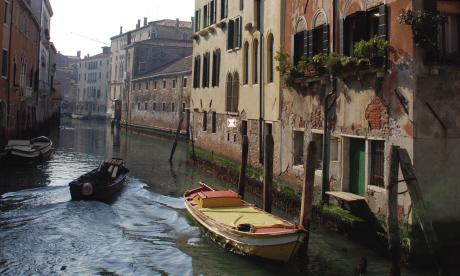 94. Get lost in Venice, Italy
94. Get lost in Venice, ItalyAway from the bustling masses of the Rialto Bridge lies a maze of courtyards, cafés and canals. Front doorsteps lead into the water, and what you might at first construe to be a dead end could turn out to be an idyllic spot to watch the gondolas float by. When you’re bewildered, take a water taxi out of the labyrinth into the laguna.
Make it happen: Many airlines fly to Venice’s Marco Polo airport, from which you can
catch a connecting bus or boat to take you into the city. High summer is best avoided.
Get more info on Venice: How to spend your first 24 hours in Venice
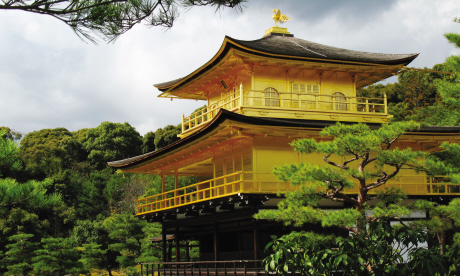 93. Uncover Kyoto, Japan
93. Uncover Kyoto, Japan“Kyoto really sums up what I had imagined Japan to be – full of beautiful ancient temples and traditions, with a thriving culture. My friend and I had three days in Kyoto to explore and could easily have stayed a week; there is so much to see! A high point was Kinkaku-ji, the Temple of the Golden Pavilion.” – Annabelle Wilkins, Wanderlust reader
Make it happen: Fly to Tokyo; Kyoto can be reached by car, train or plane.
Get more info on Kyoto: Lyn Hughes' ultimate guide to Kyoto
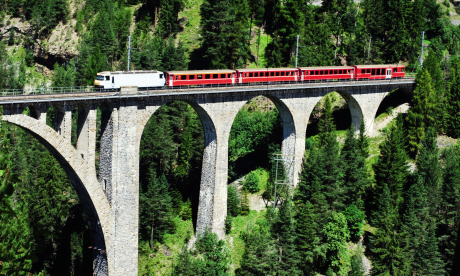 92. InterRail around Europe
92. InterRail around EuropeHow many travelling lives have started with a scrimped-and-saved-for InterRail ticket and a copy of the Thomas Cook European Rail Timetable? Since 1973, the hop-on-hop-off continental rail pass has been a rite of passage for Europeans, the budget Grand Tour – and every InterRailer has their tale to tell.
Make it happen: InterRail passes are now available for all ages and various durations: see interrail.eu
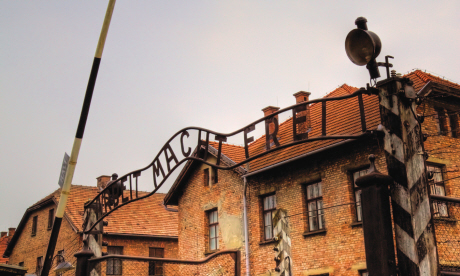 91. Visit Auschwitz, Poland
91. Visit Auschwitz, PolandGreat travel experiences aren’t necessarily great fun. Take Auschwitz: you don’t exactly enjoy walking through the corridors and scrubby wastes of the former concentration camp, but it will certainly make a lasting impression. The horror still echoes around the walls; the cabinets full of used toothbrushes, Zyklon B canisters and human hair send shivers down the spine.
Make it happen: Oswiecim (for Auschwitz) is on the Katowice-Kraków train line; Auschwitz 1 is a ten-minute walk or short bus ride from the station.
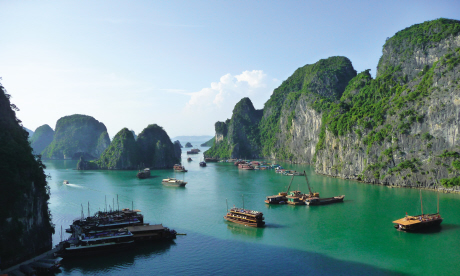 90. Hang out in Halong Bay, Vietnam
90. Hang out in Halong Bay, VietnamVietnam’s biggest attraction has commercialised fast in recent years, but this waterworld of ghostly limestone crags, caves and floating villages – seemingly lifted from a watercolour – still has the power to enthral. Vietnam War-era sites on Cat Ba island add a less fairytale dimension.
Make it happen: Budget one/ two-night tours from Hanoi are two-a-penny. For a more leisurely experience, take the ferry to Cat Ba island and explore by kayak or foot.
Get more info on Halong Bay: Wanderlust's top 5 alternative activities
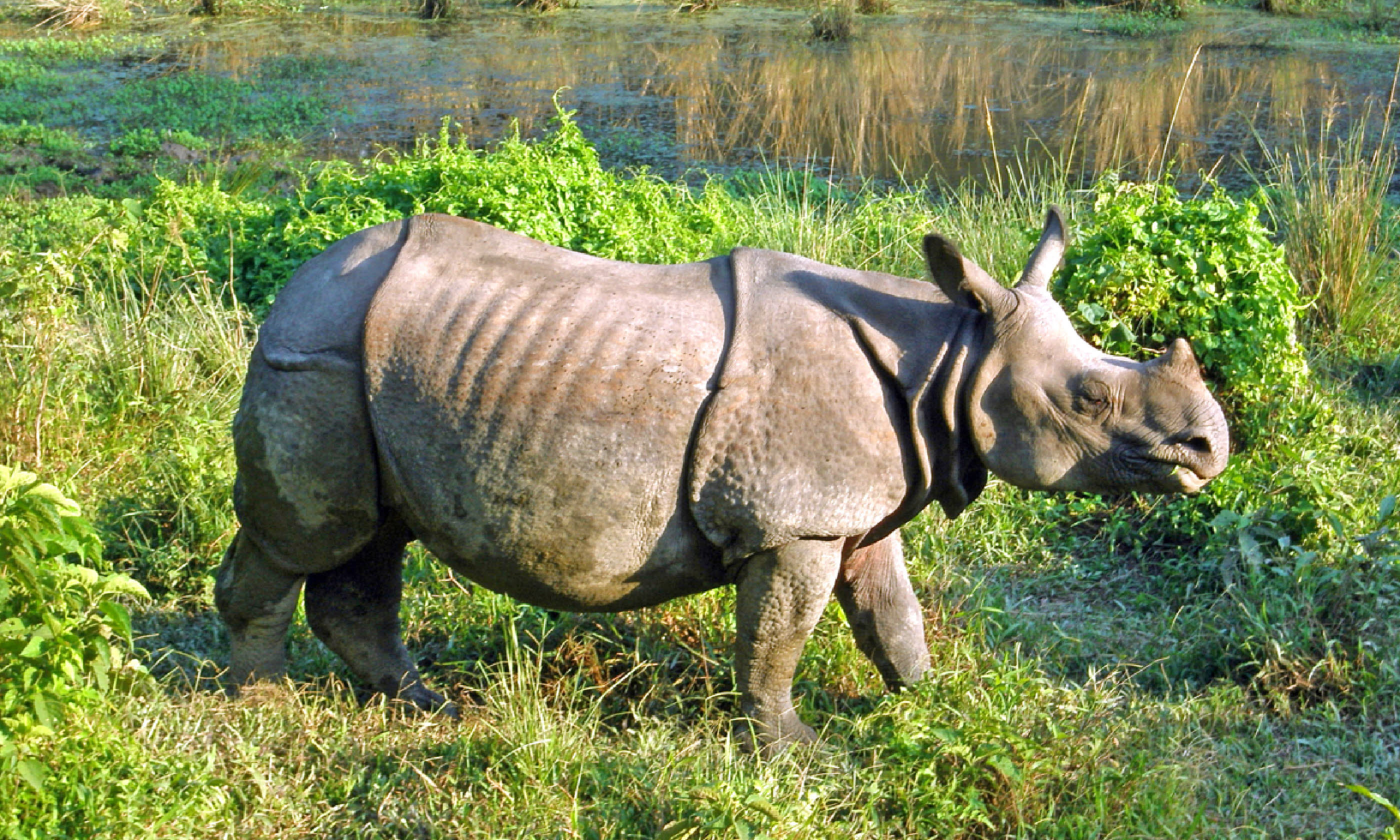
Indian one horned rhinoceros (Shutterstock)
For many readers, sitting atop an Asian elephant has been a favoured way to explore Royal Chitwan, allowing you to spot rhino, gaur, sloth bear and even tigers from a lofty spot. However, in recent years, a number of readers have raised concerns about the elephants' welfare, so you may want to consider a walking tour instead.
Make it happen: Chitwan is a six-hour drive from Kathmandu. Jan–Mar, after the long grasses have been cut, are best for wildlife viewing; Jun–Sept is very hot and wet.
Get more info on Chitwan national park: In search of rhinos
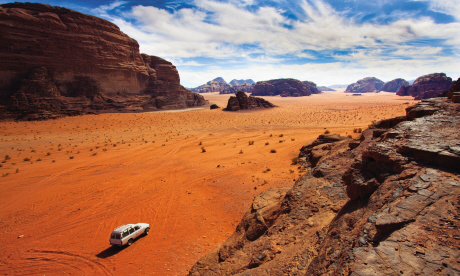 88. Sleep out in Wadi Rum, Jordan
88. Sleep out in Wadi Rum, JordanJordan’s russet landscape is one of the world’s great, accessible desert adventures. By day, Wadi Rum overwhelms with its scale, but by night the star-serried sky will leave you speechless. Tents are optional – unfurl a blanket, gaze up at the infinity of lights above, feel the dying embers of the Bedouin cooking fire – and then sleep like a rock.
Make it happen: Wadi Rum is one hour’s drive from Aqaba.
Get more info on Wadi Rum: The ultimate guide to Petra and Wadi Rum
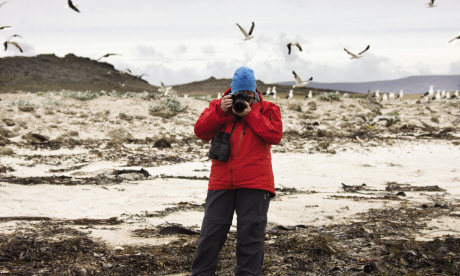 87. Go wild on the Falkland Islands
87. Go wild on the Falkland IslandsThousands of albatross, southern petrels and king cormorants ride the breeze, while down on the beaches platoons of king and gentoo penguins and elephant seals waddle and posture. Add in the Lego-like buildings of Stanley, the moving war memorials, and the appeal of hopping between islands by light aircraft, and you’ll agree there’s nowhere remotely like it.
Make it happen: It can be tricky to get to, but it's well worth the effort. See falklandislands.com for details.
Get more info on the Falkland Islands: The best places to spot wildlife | Wanderlust's guide to the Falkland Islands
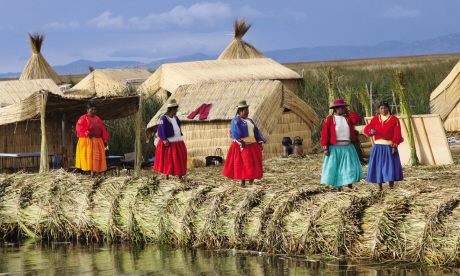 86. Live local on Lake Titicaca, Peru
86. Live local on Lake Titicaca, Peru“My experience of Lake Titicaca started with a trip to the floating Uros Islands, and then on to Taquile, where we ate delicious fried trout, and took a look round the local market, which has amazing woven products, all traditional. Then I took a boat to a tiny village, where I was treated to food, drinks, and plenty of music and dancing!” – Eleanor Mawer, Wanderlust reader
Make it happen: Lake Titicaca’s two hub towns are Copacabana (Bolivia) and Puno (Peru) – the latter is busier. You can arrange homestays on the lake at either.
Get more info on Lake Titicaca: 5 things you simply shouldn't miss on your trip
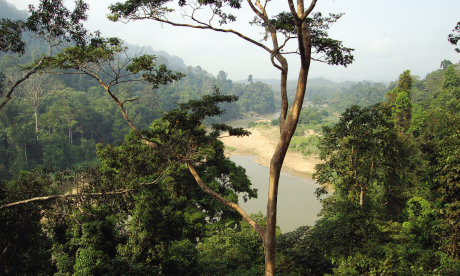 85. Hike Taman Negara National Park, Malaysia
85. Hike Taman Negara National Park, MalaysiaAt 130 million years old, the Taman Negara rainforest deserves respect when you step under her canopy. Lying 150km north-east of Kuala Lumpur, this jungle is home to elephants, Orang Asli hunter-gatherers and mysterious caves and rivers. Walkways are slung between trees, where gibbons and hill squirrels slouch in the branches.
Make it happen: Kuala Tahan is the gateway town – get there from Kuala Lumpur by train or bus via Jerantut. Tours can be booked locally or in KL.
 Get your hands on our new 100 Greatest Travel Experiences book: free with every 2016 Christmas gift subscription to Wanderlust! The perfect gift for travel lovers – and you can even keep the book if you wish (We won't tell!) Sign up here
Get your hands on our new 100 Greatest Travel Experiences book: free with every 2016 Christmas gift subscription to Wanderlust! The perfect gift for travel lovers – and you can even keep the book if you wish (We won't tell!) Sign up here
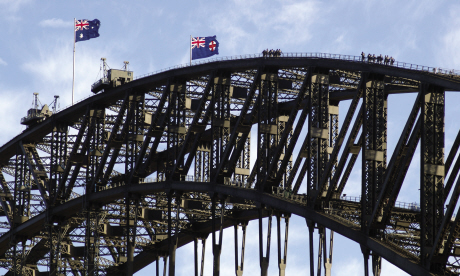 84. Climb Sydney Harbour Bridge, Australia
84. Climb Sydney Harbour Bridge, AustraliaKitted up in camouflaged climbing suits, you’ll see Sydney Harbour from a unique spot on a climb up its iconic bridge. At the top, you’re afforded astounding views over the city, including the Opera House. The views are especially magical on the dawn and twilight climbs: watch the bustling metropolis come to life far below or wind down in the dusk.
Make it happen: Guided climbs are offered exclusively by Bridge Climb Sydney
Get more info on Sydney: First 24 hours in Sydney | 7 free things to do in Sydney
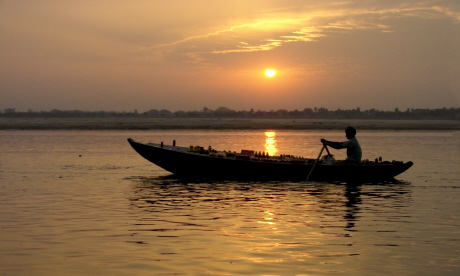 83. Get spiritual on the Ganges, India
83. Get spiritual on the Ganges, IndiaMata Ganga, or ‘Mother Ganges’, is central to India’s sense of itself, a river that’s also the spiritual backbone of the subcontinent. From its source high in the Himalayas, the river cuts west to east, emptying into the Bay of Bengal 2,510km later. Along its route lie some of India’s most sacred cities – Haridwar, Varanasi and Allahabad among them.
Make it happen: Many airlines fly direct to Delhi. From here, take a train to Haridwar and use buses or taxis to visit nearby Rishikesh.
Get more info on the Ganges: One of the world's greatest journeys
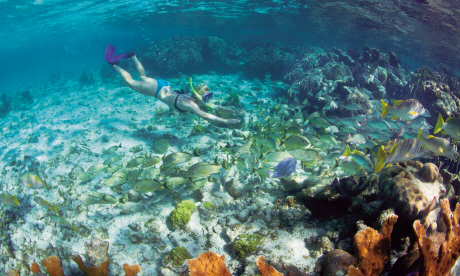 82. Swim in marine-life heaven, Caye Caulker, Belize
82. Swim in marine-life heaven, Caye Caulker, BelizeNo need for diving: the snorkelling here is world-class. Float above the coral to spot tonnes of technicolour tropical fish, toothy barracuda and glum-mouthed groupers. For even bigger specimens, flipper around the aptly named Shark Ray Alley and Shark Ray Village, where schools of nurse sharks and flapping stingrays play in abundance.
Make it happen: Reach Caye Caulker from Belize City by plane (15 minutes) or water taxi (45 minutes). The Caye is small enough to get around on foot.
Get more info on Caye Caulker: Discover little-visited Belize
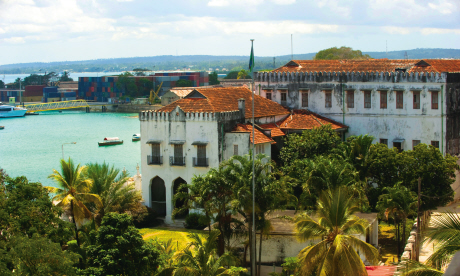 81. Spice things up on Zanzibar, Tanzania
81. Spice things up on Zanzibar, TanzaniaYour full-sensory experience of the fabled spice island of Zanzibar starts at the harbour, when you first catch a whiff of nutmeg and cinnamon stacked in hessian sacks on the dock. And it continues throughout your stay. Watch the sunset while cradling an icy beer as lateen-sailed dhows float by.
Make it happen: Fly to Dar es Salaam, and then take a boat or a prop-engined plane to the island.
Get more info on Zanzibar: Top 4 trip itineraries | 10 things to do for free on Zanzibar
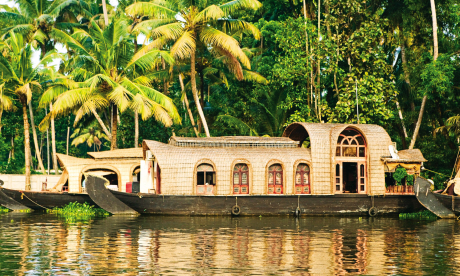 80. Slow down on the Keralan backwaters, India
80. Slow down on the Keralan backwaters, IndiaOn a kettuvallam houseboat, floating along some of the 900km of lagoons, canals, rivers and lakes, a meditative calm descends. Meals are included on a standard cruise, and the quality is usually excellent. Make sure you try some of the local fish known as karimeen – it will be among the tastiest things you’ll ever eat on the subcontinent.
Make it happen: Most backwater cruises depart between Kollam and Alappuzha; stay at least one night on the backwaters.
Get more info on Kerala: Lyn Hughes ventures beyond Kerala's beautiful backwaters
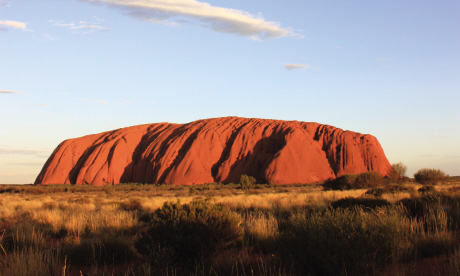 79. Watch sunrise and sunset at Uluru, Australia
79. Watch sunrise and sunset at Uluru, AustraliaSet your alarm early to see the inky Outback sky turn purple, and the sleeping monolith awaken, its nighttime shadow brightening to warm browns and rich reds with the rising sun. At midday, rays spotlight Uluru’s every crag and crevice (best seen on the 10km round-rock Base Walk). Come dusk, old Ayers blazes orange – a last hurrah.
Make it happen: There are various sunrise/set viewpoints within the national park: Talinguru Nyakunytjaku lookout offers views of Uluru and Kata Tjuta (the Olgas).
Get more info on Uluru: The Wanderlust icon guide
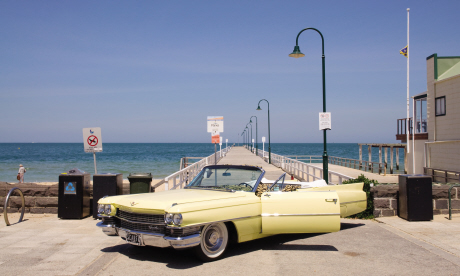 78. Get your motor running on a road trip, USA
78. Get your motor running on a road trip, USAWhen we think of the all-American road trip, it’s difficult not to view it as a series of nostalgic vignettes: a cherry-red Chevy; a roadside burger joint straight out of an Edward Hopper painting; the neon sign for some remote church glowing with the promise of redemption. And the great thing is, you’ll find it all (and more) when you hit the highway...
Make it happen: For inspirational route ideas and information on logistics, see roadtripusa.com. Hiring an RV motorhome can keep down costs; check out cruiseamerica.com.
Get more info on taking a road trip: USA campervan roadtrip tips
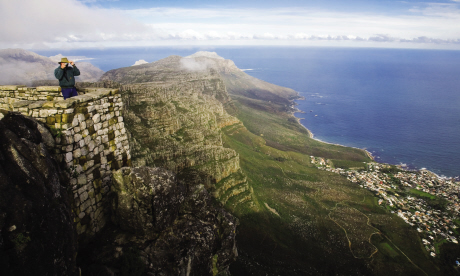 77. Climb Table Mountain, Cape Town, South Africa
77. Climb Table Mountain, Cape Town, South AfricaNot one for the indecisive, there are more than 350 routes to the top of Table Mountain – such is the lure of the squat, cloud-shrouded monolith that lords it over Cape Town and the Atlantic beyond. The route you choose depends on your skill level: some options are for experienced climbers only, but many are manageable by more casual walkers.
Make it happen: Visitors to Table Mountain National Park must pay a standard conservation fee on entering: R80 (£7.20) a day for adults, R20 (£1.80) for children.
Get more info on Cape Town: How to spend your first 24 hours in the city | 7 things to do on the cheap in Cape Town
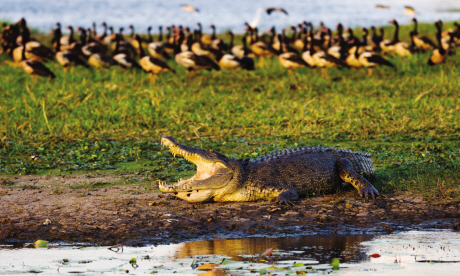 76. Go wild in Kakadu National Park, Australia
76. Go wild in Kakadu National Park, AustraliaThis vast park (at 20,000 sq km, the country’s biggest) is the sweltering Outback, croc-infested wetland, roo-hopped scrub and art-daubed rock of your Oz imagination. Here, cliché becomes spectacularly three dimensional; you can feel millennia of red dust and Aboriginal history hanging in the air.
Make it happen: Kakadu is a three-hour drive from Darwin. Some areas are inaccessible in the Wet (Oct-Mar); Jun to mid-Aug is best for wildlife-watching.
Get more info on Kakadu NP: 9 things you should do in Australia's Top End
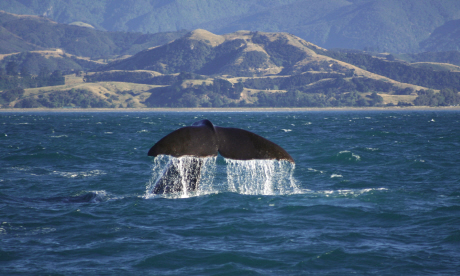 75. Whale-and-dolphin-watch, New Zealand
75. Whale-and-dolphin-watch, New ZealandWhere waters collide – tropical hot and Antarctic chilled – so too do fish. And where fish gather, so too do mammals that like to eat them. Thus it is that the seas off New Zealand are a hearty stew of wildlife, the waves thick with dusky dolphins, orca, humpbacks, sperm whales, even the mighty blue..
Make it happen: Kaikoura (South Island) is a marine-mammal hotspot. Sperm whales are seen year-round; Jun-Jul is the best time to see humpbacks.
Get more info on whale watching: Wanderlust's NZ travel guide
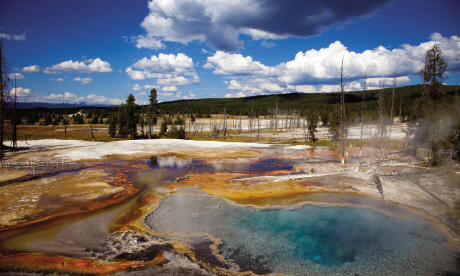 74. Admire Yellowstone National Park, Wyoming, USA
74. Admire Yellowstone National Park, Wyoming, USATake a trip into the heart of the Rocky Mountains and you’ll find an extraordinary wilderness ruled by extremes of fire and ice. Fed by the energy of a volcanic caldera, half of the whole world’s geothermal features are located in Yellowstone. They include burbling mudpots, sulphurous cauldrons and the explosive Old Faithful geyser.
Make it happen: From the nearest international airport at Salt Lake City, Yellowstone is a 625km drive. Domestic flights to Jackson or Cody in Wyoming will take you within 80km of the park. Visit the US National Parks site for brochures, maps and trip planners.
Get more info on Yellowstone: Tracking wolves in Yellowstone
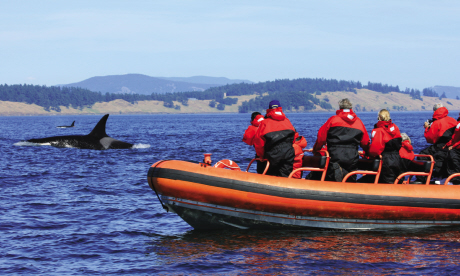 73. Watch whales in the Gulf of St Lawrence, Canada
73. Watch whales in the Gulf of St Lawrence, CanadaDespite a history of whalers firing their harpoons here, the deep and krill-filled St Lawrence River remains one of the world’s greatest whale-watching waterways. Come here to see acrobatic humpbacks, 25m-long blues, almost-as-massive fins and seemingly smiling belugas. Hop in a kayak and paddle out into the whales’ world...
Make it happen: Peak season is May-Sept. Boat trips leave from spots such as Tadoussac and Baie-Sainte-Catherine. Spot from land on the 900km Whale Route along the North Shore.
Get more info on St Lawrence: A glimpse of Beluga whales on a self-drive trip | Glacier hunting on the St Lawrence river | Where to see whales in Canada
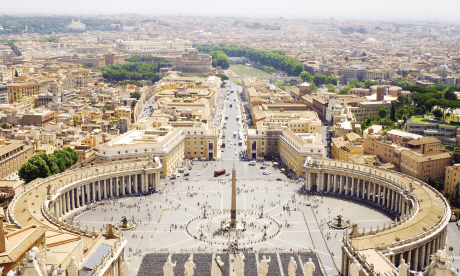 72. Roam Rome and the Vatican, Italy
72. Roam Rome and the Vatican, ItalyIf Rome was a gelato (a food, incidentally, in which the city excels) it would be tutti frutti – a confection of countless fruits and flavours. It’s a metropolis-sized museum, endlessly intriguing. The big sites are obvious: Colosseum, Forum, the Vatican’s St Peter’s. But it’s the cumulation of so much old in one place that makes Rome so delicious.
Make it happen: One ticket (€12, valid for two days) covers entry to the Colosseum, Forum and Palatine Hill sites. Admission to the Vatican Museums, including the Sistine Chapel, costs €15.
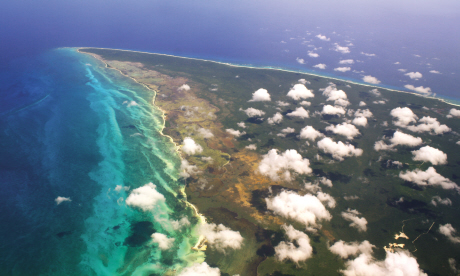 71. Dive the cenotes, Yucatán, Mexico
71. Dive the cenotes, Yucatán, MexicoThe jungly Yucatán peninsula, devoid of obvious lakes and rivers, is dimpled instead by thousands of soggy cenotes – sinkholes fed by underground springs. Popular chasms include Ik-Kil, near Chichén Itzá, deep and inky Azul and Kankirixche, atmospherically riddled with tree roots. Dive in to float above strange rock formations.
Make it happen: Swim sensitively: wear biodegradable sunscreen; do not touch or break off bits of rock; be wary of hitting stalagmites with flippers.
Get more info on the Yucatán: 4 ways to travel the Mayan route | 4 great Mexico itineraries
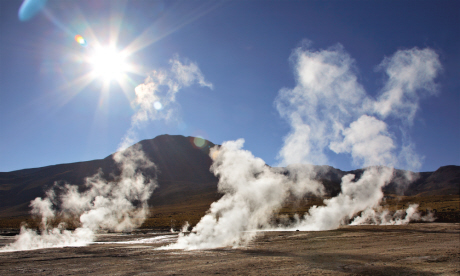 70. Atacama Desert and El Tatio geysers, Chile
70. Atacama Desert and El Tatio geysers, ChileMake it happen: San Pedro de Atacama is 98km from the nearest airport at Calama. Aim to spend at least four days, not least to adjust to the altitude.
Get more info on the Atacama Desert: Wanderlust's travel icon guide
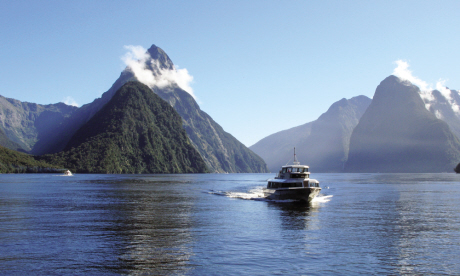 69. Sail out on Milford Sound, New Zealand
69. Sail out on Milford Sound, New ZealandCruises out into the Milford Sound fiord pass its steep rock sides, carved by ancient glaciers, plus you’ll see your fair share of charging waterfalls and local residents: fur seals, dolphins and little penguins among them. Book an overnight sail to drop anchor in a remote cove, for a magical Sound sleep.
Make it happen: Milford Sound is a 2.5-hour drive from Te Anau or a 35-minute scenic flight from Queenstown.
Get more info on Milford Sound: Wanderlust's travel icon guide
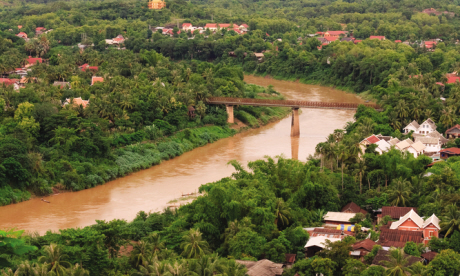 68. Boat up the Mekong, Laos
68. Boat up the Mekong, LaosAny boat trip on the fabled Mekong has a certain allure, but when you’re heading for Luang Prabang, there’s an additional dose of anticipation. Laos’ celebrated town of temples and colonial villas hugs the river’s banks.
Make it happen: Slow boats depart daily for Luang Prabang from the Thai border at Huay Xai – you can overnight at Pakbeng. Speedboats (6 hours) and luxury cruises are also on offer. Alternatively, start your boat trip from Luang Prabang.
Get more info on Luang Prabang: Luang Prabang city guide | The best bits surrounding Luang Prabang
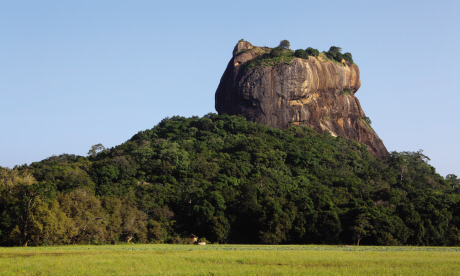 67. Stand atop the rock city of Sigiriya, Sri Lanka
67. Stand atop the rock city of Sigiriya, Sri LankaWoven into a 150m-high pillar of rock, this incredible feat of human ingenuity dating to the fifth century AD was once home to kings and, later, Buddhist monks. Explore the water garden, boulder garden and terrace gardens, and ascend through the levels of the city to see the ancient fresco paintings that make this a Unesco World Heritage site.
Make it happen: Sigiriya is a 90km drive from the city of Kandy, which has bus and rail links to capital Colombo.
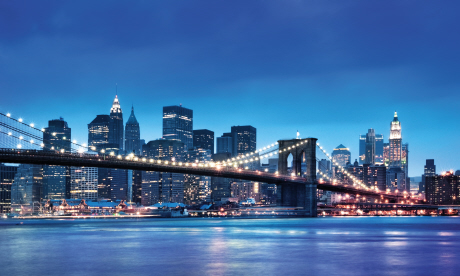 66. Feel like a movie star in New York, USA
66. Feel like a movie star in New York, USAThe first time most people see the Manhattan skyline there is, ironically, something unreal about it. Here you are in soft-focus taking a romantic stroll over the Brooklyn Bridge; now you’re glamming it up amid the neon-lit fizz of Times Square; come the morning you’ll be brooding on a boat across from the Statue of Liberty and Ellis Island.
Make it happen: Get to know the city through a local’s eyes (for free) – go to bigapplegreeter.org.
Get more info on New York City: 7 things to do for free | How to spend your first 24 hours in NYC | 5 secrets about NYC's subway | An island-hopping weekend in NYC
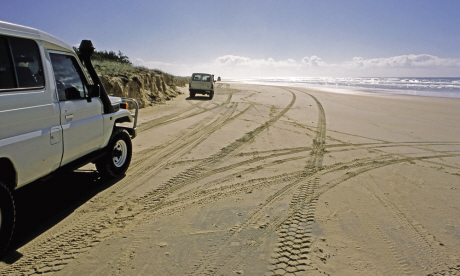 65. Have fun on Fraser Island, Queensland, Australia
65. Have fun on Fraser Island, Queensland, AustraliaFraser feels like nature’s theme park, a place where lakes, dunes and streams seem built for human fun. Four-wheel drive across the beaches to access the ‘rides’ – Champagne Pools’ fizzing surf, the dark depths of Lake Wabby, a gentle float with the fish down Eli Creek and the perfect-blue shallows of Lake Mckenzie.
Make it happen: Fraser is 15km offshore from Hervey Bay, 300km north of Brisbane. A 4WD is necessary to drive the island’s beaches and inland roads; purchase permits before arrival.
Get more info on the Great Barrier Reef: Wanderlust's ultimate guide | Australia's ten biggest secrets
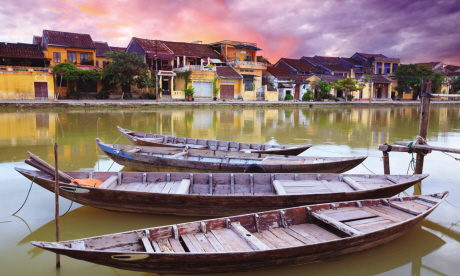 64. Browse Hoi An, Vietnam
64. Browse Hoi An, VietnamHoi An is an elegant waterfront harbour of 18th-century merchant houses, ornate pagodas and French colonial airs. You’ll nose into museums, sip café au laits overlooking the Thu Bon River – and then you’ll buy clothes. Suits for £20, cocktail dresses, shirts... and before you know it, you have fitting appointments all over town.
Make it happen: Hoi An is halfway between Saigon and Hanoi; the nearest train station is 30km away at Danang. Remember to leave space in your bags for a new wardrobe.
Get more info on Hoi An: Could this be the best city on earth? | 5 mouth-watering moments in Hoi An
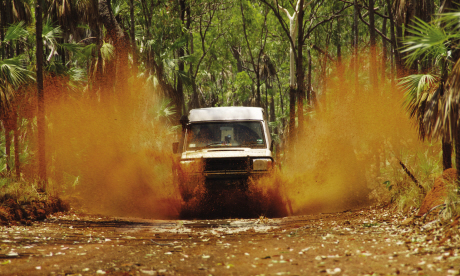 63. Fancy-free back-packing, Australia
63. Fancy-free back-packing, AustraliaIt’s an adventure for a gap year or a career break, a turning point in your life. Somehow, you have a month – maybe three months, or more – and nothing to hold you back. Australia beckons, its vast red blanks on the map as enticing as the coastal cities you’ll start from...
Make it happen: Hire a campervan from Maui or Britz; or browse second-hand vehicles for sale at gumtree.com.
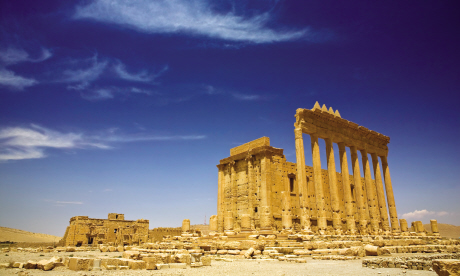 62. Roam the Roman city of Palmyra, Syria
62. Roam the Roman city of Palmyra, SyriaIn the dawn light, the columns and arches are infused with a honeyed glow. During the day, both the temperature and the touts are too intense, so head off for some shade – try exploring the Arab castle on the hill, the Qala’at Ibn Maan. As the evening draws in, this becomes the ideal vantage point to take in the full extent of the ruins.
Make it happen: From Damascus, taking a minivan is a popular, cheap option. Check the Foreign Office for the latest safety information and travel advice.
Get more info on Palmyra: Ben Oliver discovers Syria is friendly, colourful and steeped in history
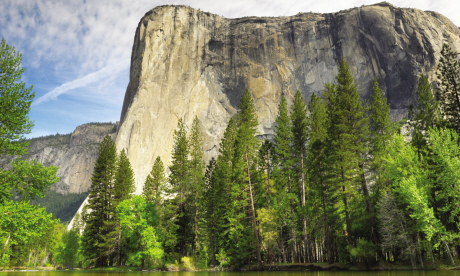 61. Yomp around Yosemite National Park, California, USA
61. Yomp around Yosemite National Park, California, USAYosemite has been a national park since 1890, and every year hordes descend on its riverside meadows, pine forests and rockfaces. Set up camp, stash comestibles in your bear locker and hit one of the many hiking trails; plan your trip for autumn, when most areas of the park are still open but the crowds have gone home.
Make it happen: Yosemite is 314km from San Francisco. The park is open year-round but some roads are inaccessible Nov-May.
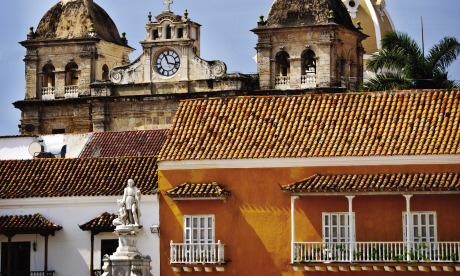 60. Stroll old Cartagena, Colombia
60. Stroll old Cartagena, ColombiaOne of the finest colonial cities in the Americas, Cartagena was once a strategic shipping post for the vast riches amassed by Spanish plunder. Today, much of the original walls (built in 1616) remain, topped by cannons and flagpoles. Stroll amid the attractive plazas, grand mansion houses and charming cobblestone streets.
Make it happen: Colombia’s dry season is December to March, with a second dry season June-August. Visitors typically fly in via the US and Bogotá.
Get more info on Cartagena: Trip ideas for Cartagena and northern Colombia
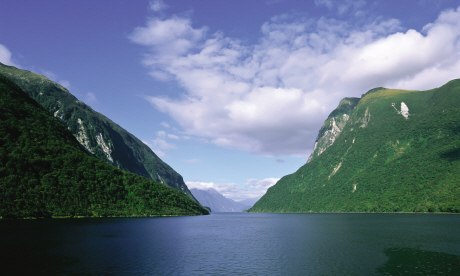 59. Kayak in Fiordland, South Island, New Zealand
59. Kayak in Fiordland, South Island, New Zealand This glacially gouged chunk of South Island’s south-west is riven with inlets, well rinsed by waterfalls, and receives 8m of rain each year. Kayaks are the ideal vessel – for paddling into coves and bays unreachable on foot, and for meeting the seals, penguins and bottlenose dolphins that call it home.
Make it happen: Te Anau is Fiordland’s main hub. From there it’s a 20km drive to Manapouri, followed by a 30km boat trip across the lake to reach Doubtful Sound.
Get more info on kayaking in New Zealand: The best sea adventures
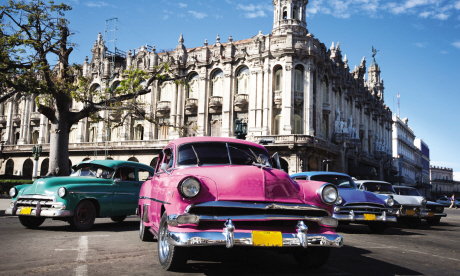 58. Sample sultry salsa nightlife in Havana, Cuba
58. Sample sultry salsa nightlife in Havana, CubaThrough the cigar smoke comes the sound of feet stamping, hands clapping, dresses swishing. Two women sashay towards their partners, men wearing neatly positioned bowler hats and wicked smiles. “Aqui, aqui!” they shout, and the women move towards them, while other Cubans holler and cheer, moving to the beat. Now who wouldn’t want to be part of that vibe?
Make it happen: Don't just leave it to the professionals: many tour operators offer dance classes for travellers.
Get more info on Havana: How to spend your first 24 hours in Havana | A quick guide to gay Havana | Travel Icon: Old Havana
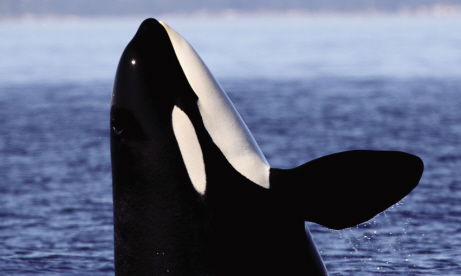 57. Sea-kayak with orca, Canada
57. Sea-kayak with orca, CanadaYou sometimes hear them before you see them: the whoosh of air as they draw breath before diving. Or you’ll see the huge dorsal fin of an adult male as he slices through the water, and then realise there is in fact a whole family pod. Out on the water, you in your flimsy-seeming kayak, you realise just how big and powerful they are.
Make it happen: June to October is best for orcas. Fly to Vancouver, then take the ferry to Vancouver Island; there are plenty of local outfitters who can arrange kayaking trips.
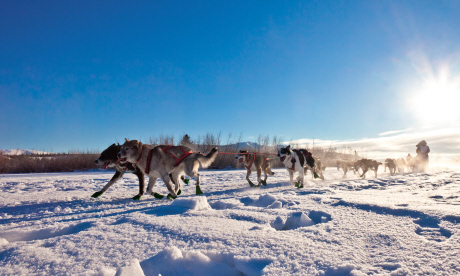 56. Husky mush in Lapland, Sweden
56. Husky mush in Lapland, Sweden“We were taken out on the sleds, with six to eight dogs leading and the guide steering the sleighs. It was incredible. But the real fun was the next day when we did it ourselves. We were on shorter sleighs with three dogs each, and after a quick run we were off, racing over frozen lakes and through the trees.” – Liz Davies, Wanderlust reader
Make it happen: Numerous tour operators offer dog-sledding trips in Sweden – check out Trip Finder Wanderlust’s recommended companies.
Get more info on husking mushing: Wanderlust's complete travel guide
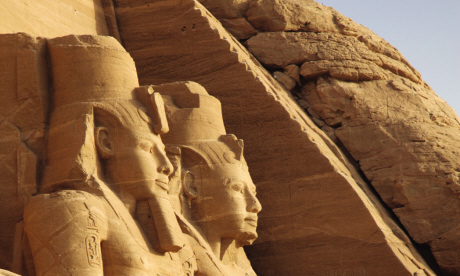 55. Temple-gaze at Abu Simbel, Egypt
55. Temple-gaze at Abu Simbel, EgyptThese big, old and beautiful monuments are so great they were actually built twice. Originally carved out of a cliff to honour Ramses II in the 13th century BC, the Great Temple and smaller Temple of Hathor were then cut up and relocated, block by block, in the 1960s to save them from the waters of the Nile, caused by the creation of Lake Nasser. Secure on the new riverbank, the 33m-high facade impresses and interrogates visitors, just as it has for thousands of years.
Make it happen: There are sound and light shows 7pm-10pm, which add another dimension. Avoid visiting in the afternoon, when temperatures are at their max.
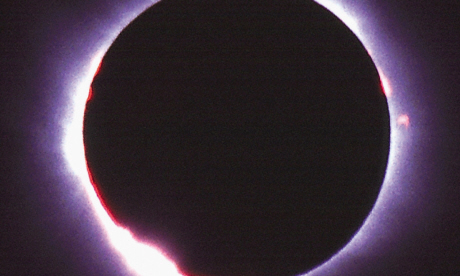 54. See a solar eclipse
54. See a solar eclipseMost of us at one time or another have squinted through a pinhole in a piece of cardboard or donned a pair of particularly dark glasses to get a look at a solar eclipse. But some travellers are eclipse-chasers, traversing the globe in search of total solar eclipses (which come around every 18 months on average).
Make it happen: A number of tour operators run trips combining eclipse-watching with soft adventure.
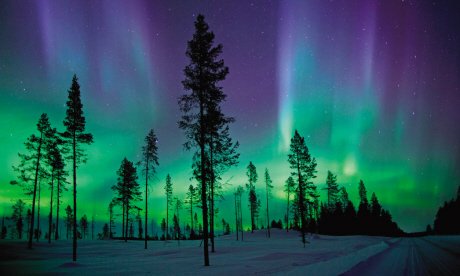 53. Be bewitched by the northern lights
53. Be bewitched by the northern lights"We huddled expectantly outside the dimly lit hut at Abisko, Sweden. The cold was forgotten as the clouds parted and we were all stunned into silence as the greens spread across the sky before they were joined by reds. It was easy to see why in older times people revered them as signs of the gods.” – James Kemp, Wanderlust reader
Make it happen: As well as Kiruna, good places to see the northern lights include Svalbard, Tromsø (Norway), Yellowknife (Canada) and Wiseman (Alaska).
Get more info on the northern lights: Wanderlust's complete travel guide
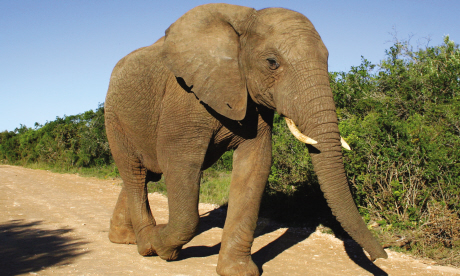 52. Get up-close with elephants, South Africa
52. Get up-close with elephants, South Africa You’re standing opposite a young bull elephant that may or may not be about to charge. Even as a junior jumbo, it’s very, very big – perhaps a third bigger than the Asian elephants you may have seen in Thailand or India. Emotions are at their most intense on a walking safari, getting you back to your roots rather than encased in a jeep.
Make it happen: Addo Elephant Park on the Eastern Cape is the third-largest national park in SA and home to the densest population of elephants in the world.
Get more info: Wanderlust's guide to wildlife and safaris | Wanderlust's guide to travel in South Africa
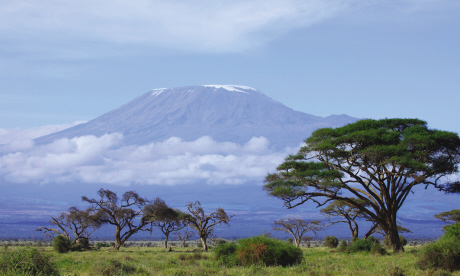 51. Climb Kilimanjaro, Tanzania
51. Climb Kilimanjaro, Tanzania Whether you rate a schlep up Africa’s highest mountain as a ‘great travel experience’ depends on when you’re asked. Ask the climber making the final push to the summit – an ascent from 4,000-ish metres to 5,895m – and they’ll likely say not. At that moment it’s a tough, cold, nauseating, exhausting hell. But ask them six hours later, when they’re grinning like an idiot on the roof of a continent, and the answer will be very different.
Make it happen: There are five main routes up Kilimanjaro: Machame, Marangu, Lemosho/Shira, Rongai and Umbwe. Climbs take 5-9 days; longer treks allow better acclimatisation.
Get more info on climbing Kilimanjaro: A practical guide for making the climb | Wanderlust'stravel guide to Mount Kilimanjaro | A day-by-day account to the climb
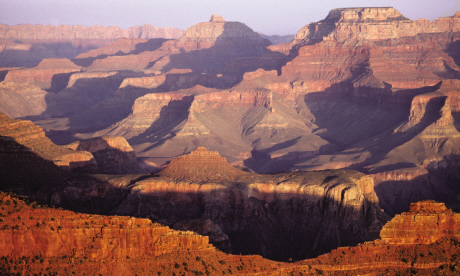 50. Gawp at the Grand Canyon, USA
50. Gawp at the Grand Canyon, USANot surprisingly, Arizona’s world-beating Grand Canyon – up to 29km wide and 1.6km deep – featured varied and often among your top travel experiences: you climb it, hike it, raft it, fly over it or simply palpitate on the edge of it, consumed by the ineffable geological scale.
Make it happen: The Canyon is accessed via the nearby cities of Las Vegas (approx 450km) and Phoenix (370km). Plane and helicopter trips leave from these hubs; otherwise expect a four to six-hour drive, depending on which Rim you’re aiming for.
Get more info on Great Canyon: All you need to know for a trekking trip | How to escape the crowds at the Grand Canyon
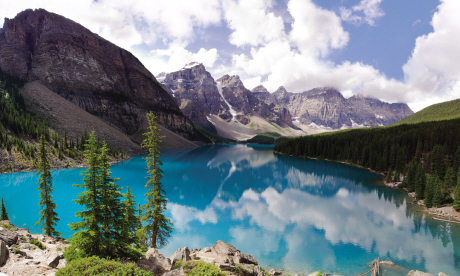 49. Explore Banff National Park, Canada
49. Explore Banff National Park, CanadaIn winter, skiers love the sheer scale of it, the flinty vistas spread out under cobalt sky. Oh, and the skiing, of course. In the summer, a drive down the Icefields Parkway has you floored in admiration, with spectacular views of mountains, rivers, lakes, forests, glaciers, icefields and, if you’re lucky, the occasional brown bear.
Make it happen: Fly into Vancouver and then take the Rocky Mountaineer train, a two-day journey east to Banff.
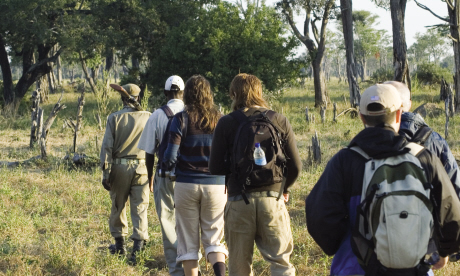 48. Walking safari in South Luangwa National Park, Zambia
48. Walking safari in South Luangwa National Park, ZambiaThis is one of the best places in the world to see leopards. This was also where the concept of the walking safari was born, and exploring on foot will really help you appreciate the bush. Once you’ve sampled Luangwa, safaris elsewhere will be spoiled forever.
Make it happen: Mfuwe is the gateway to the park; there are daily flights from Lusaka and Livingstone.
Get more info on walking safaris: Lyn Hughes on her experiences in Zambia
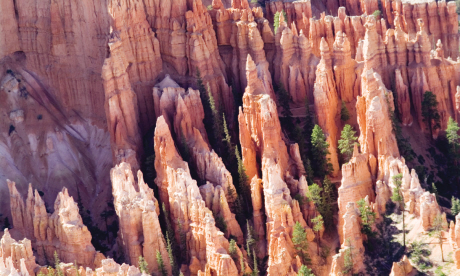 47. Rock out in Utah’s canyons, USA
47. Rock out in Utah’s canyons, USAThe national parks of Zion and Bryce Canyon are the most popular and, beyond simply gawping, are great for hiking, adventure sports and wildlife – you’ll see coyote, mule deer, bighorn sheep and, if you’re really lucky, mountain lion.
Make it happen: Fly to Salt Lake City. Hire a car and use Utah’s Scenic Byways to link the parks.
Get more info on Utah: Top 5 national parks
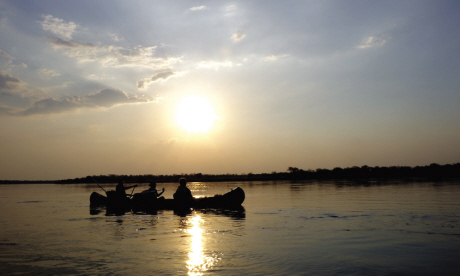 46. Raft the Zambezi, Zambia
46. Raft the Zambezi, ZambiaThe Zambezi divides Zimbabwe and Zambia. After it takes a 100m-plus tumble over Victoria Falls, it squeezes through a narrow gorge for 120km, boiling up into the biggest sequence of Grade V rapids in the world. Make sure you hold on tight or you’ll be in the Zambezi – along with the hippos and the crocodiles...
Make it happen: The best time to raft the Zambezi is when the water levels are lower and more rapids are accessible, between August and mid-October.
Get more info on rafting the Zambezi: Take it easy on the Zambezi | Robert Twigger rafts the river
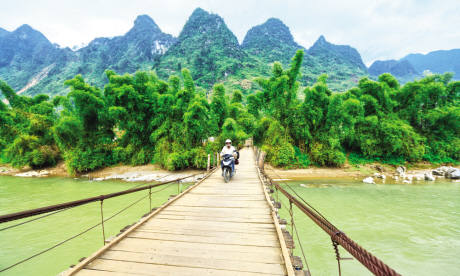
There are more than 60 glaciers sliding down to the west coast of New Zealand’s South Island. Franz Josef is one of the most impressive, galloping from the 3,000m highs of the Southern Alps to sea level in a few kilometres. Swoop over in a helicopter – look down on chilling crevasses, towering seracs and sculpted caves.
Make it happen: Several operators offer helicopter trips over Fox and Franz Josef glaciers; scenic flights last 20-40 minutes (with snow landing), heli-hiking tours last three hours.
 44. Motorbiking or biking, Vietnam
44. Motorbiking or biking, VietnamYou don’t have to be crazy to want to cycle or motorcycle in Vietnam, but it helps. Ho Chi Minh City is a maelstrom of scooters, cycles and cyclos. If you see a break in the traffic, go for it. Just make sure that the guy with a dozen live ducks hanging off his handlebars doesn’t beat you to it.
Make it happen: The best time to visit Vietnam is November-April, the dry season – though the highlands can be chilly at this time.
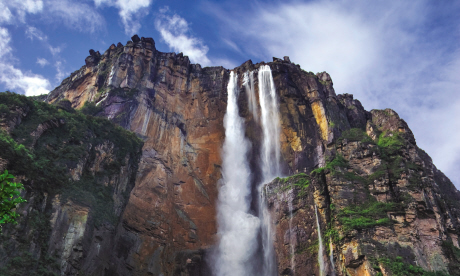 43. Paddle to Angel Falls, Venezuela
43. Paddle to Angel Falls, VenezuelaWith a drop of 979m, Angel Falls makes Niagara look like a garden water feature. Approach by dugout canoe from Canaima Camp, floating through lush rainforest, before a jungle trek to the vantage point of El Mirador de Laime. Adrenalin-junkies may choose to scale the canyon’s face before base-jumping off the top.
Make it happen: From Caracas you can travel to Ciudad Bolivar by bus; from there the only way into Angel Falls / Canaima is to fly.
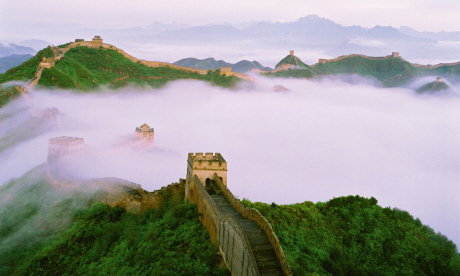 42. Walk the Great Wall of China, China
42. Walk the Great Wall of China, ChinaThe experience of walking along the entire Great Wall of China would be life-changing indeed. Seek out the less crowded sections. The Gubeikou to Jinshanling stretch is still accessible from capital Beijing, and showcases the barrier at its best: rugged walking via Wall and watchtowers as it snakes over the mountains.
Make it happen: Gubeikou is a three-hour drive north of Beijing; the walk to Jinshanling (10km) takes around five hours. Or head to Simatai, north-east of Beijing, for views of the Wall clinging to sheer Yanshan Mountain.
Get more info on the Great Wall of China: Wanderlust's complete travel guide
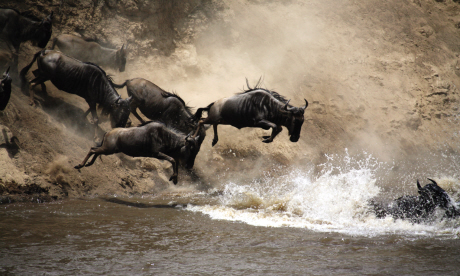 41. See the Great Migration, Kenya/Tanzania
41. See the Great Migration, Kenya/TanzaniaThe Masai Mara National Reserve and Serengeti National Park are famous for the Great Migration: two million wildebeest trek in a constant search for food. From June to September the herds bottleneck at the crossings of the Grumeti and Mara rivers, creating a feast for waiting carnivores.
Make it happen: Fly to Nairobi (Kenya) or Arusha (Tanzania). Pick up a safari locally, or pre-book with a specialist.
Get more info on the Great Migration: Top 15 tips for cracking photos | Great Migration calendar: 12 months, 12 ways | Wanderlust's travel guide to the Great Migration
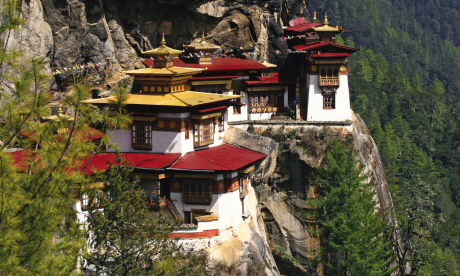 40. Climb to Tiger’s Nest, Bhutan
40. Climb to Tiger’s Nest, Bhutan This tumble-tiered fortress of white-washed walls and fluted roofs dangles 1,000m above the Paro Valley. It’s built on the site of a sacred cave, which Lotus-born Buddha, Guru Rinpoche, was said to have flown to on the back of a tiger; today, the temple in his honour looks like it might fall if not for the Buddha’s blessing.
Make it happen: Tiger’s Nest is 5km from Kyerchu. The road ends at 2,600m; a one-hour walk leads to a café and viewpoint (2,940m), followed by a steep climb to the observation point (3,140m).
Get more info on Bhutan: Discover the best awe-inspiring treks and temples
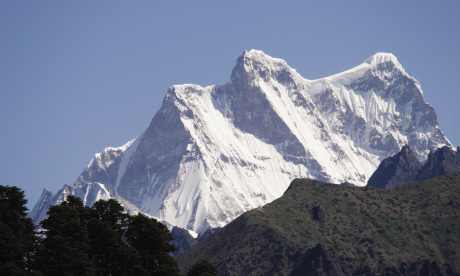 39. Glimpse the peaks of the Himalaya
39. Glimpse the peaks of the HimalayaThere’s nothing bigger – nothing more wobble-you-in-your-walking-boots awesome – than the high Himalaya. The entire range spans 2,400km, from Pakistan in the west to India in the east; much of it lords over 7,000m, some of it over 8,000m – a height not approached elsewhere on the planet.
Make it happen: Himalaya hub cities include Kathmandu, Lhasa, Islamabad, Paro, Delhi and Guwahati; take the train to Shimla from Delhi (via Kalka; approx 12 hours) for easily accessible views.
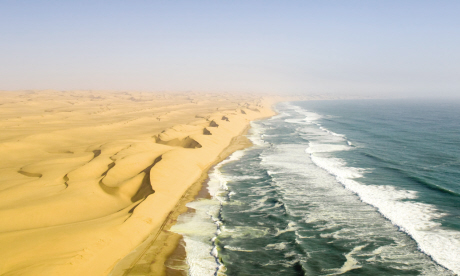 38. Fly over the Skeleton Coast, Namibia
38. Fly over the Skeleton Coast, NamibiaNamibia’s Skeleton Coast is a no-man’s land of starkly spectacular proportions. It’s a place where bleached whale bones and the rusting hulks of shipwrecks line miles of empty sand; where shores sparkle with gem stones; where a few resilient animals – jackal, oryx, desert-adapted elephant – patrol the dunes.
Make it happen: The 200km from Swakopmund to the Ugab River is the National West Coast Tourist Recreational Area; no permits are required. Skeleton Coast National Park begins at the Ugab; the far north can only be visited by fly-in tour.
Get more info on the Skeleton Coast: William Gray's guide to the Namib Desert
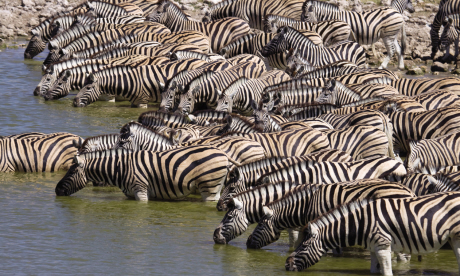 37. Waterhole-watch in Etosha National Park, Namibia
37. Waterhole-watch in Etosha National Park, Namibia A smatter of ungulates – zebra, impala, oryx – takes watchful slurps. A warthog trots by, tail raised like a radio antenna. Three lions, with blood-stained chops, demolish an unfortunate creature under a mopane tree – until a huffy elephant decides to ruin their picnic. Just another day at the waterhole...
Make it happen: Etosha is a six-hour drive north of Windhoek. Three government camps within the park have floodlit waterholes for nighttime wildlife-viewing.
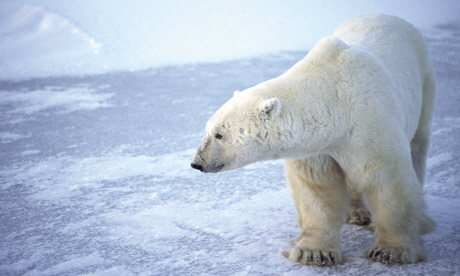 36. Look out for bears, Canada
36. Look out for bears, CanadaHere, beasts weighing up to 450kg might be seen in the mountains or, come salmon-spawning season, standing mid-river, mouths open, waiting for lunch to jump right in. A special treat is an encounter with a blonde-furred spirit bear, a rare sub-type that inhabits the vast Great Bear Rainforest, and holds a special place in Native Indian legend.
Make it happen: Generally, May-October is best for bear-watching. Obey the rules: clear up rubbish, keep food in a bear locker, never surprise or approach a bear.
Get more info on bear-watching in Canada: Scouts out Churchill's surroundings | Take an adventure with local Inuits
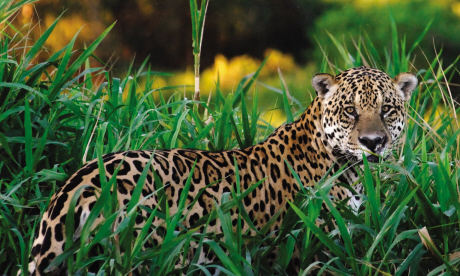 35. Jaguar-spot in the Pantanal, Brazil
35. Jaguar-spot in the Pantanal, BrazilThe Amazon has size and fame, but it’s in the Pantanal – Brazil’s lesser-known great green wilderness – that you’re more likely to meet the residents. A lot lives in this vast wetland: giant otter, giant anteater, giant water lilies, huge caiman, umpteen birds. And jaguars, which – incredibly for this elusive cat – are regularly spotted.
Make it happen: In the north, the Transpantaneira Highway runs for 145km from Poconé (near Cuibá) to Porto Jofre; Campo Grande is the main access point for the southern areas of the Pantanal.
Get more info on the Pantanal: Lyn Hughes' guide to spotting jaguar
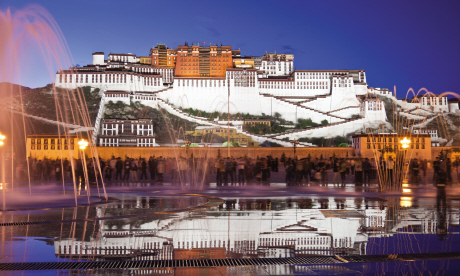 34. Visit the Jokhang and Potala palace, Lhasa, Tibet
34. Visit the Jokhang and Potala palace, Lhasa, TibetJokhang Temple, in the centre of old Lhasa, is proof of the nation’s spiritual life. It’s a kaleidoscope of colourful prayer flags and trinket stalls where monks and farmers jostle for position on the pilgrim path that surrounds it. At its heart sits a temple where each morning crimson-robed monks chant in the glower of a thousand yak-butter candles.
Make it happen: Trains run from Xining to Lhasa; journey time is around 24 hours. Overland tours run from Nepal.
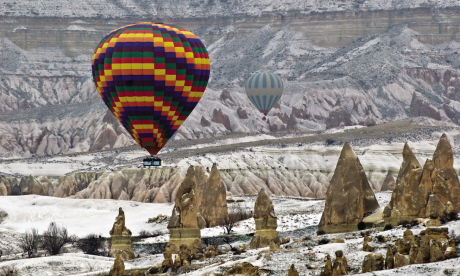 33. Explore Cappadocia, Turkey
33. Explore Cappadocia, TurkeyAround AD 600, early Christians burrowed into the Anatolian plateau's soft volcanic rock, creating underground homes, churches and monasteries. The result: a unique cultural adventure playground. Take a balloon ride to see the patchwork unfold beneath you. Or spend a night in your very own cave hotel.
Make it happen: Kayseri is the gateway city – fly via Istanbul, or take the train. The laid-back village of Göreme is a good base for hikes and ballooning.
Get more info on Cappadocia: Travel Icon guide to Cappadocia | Top 6 walks around Cappadocia
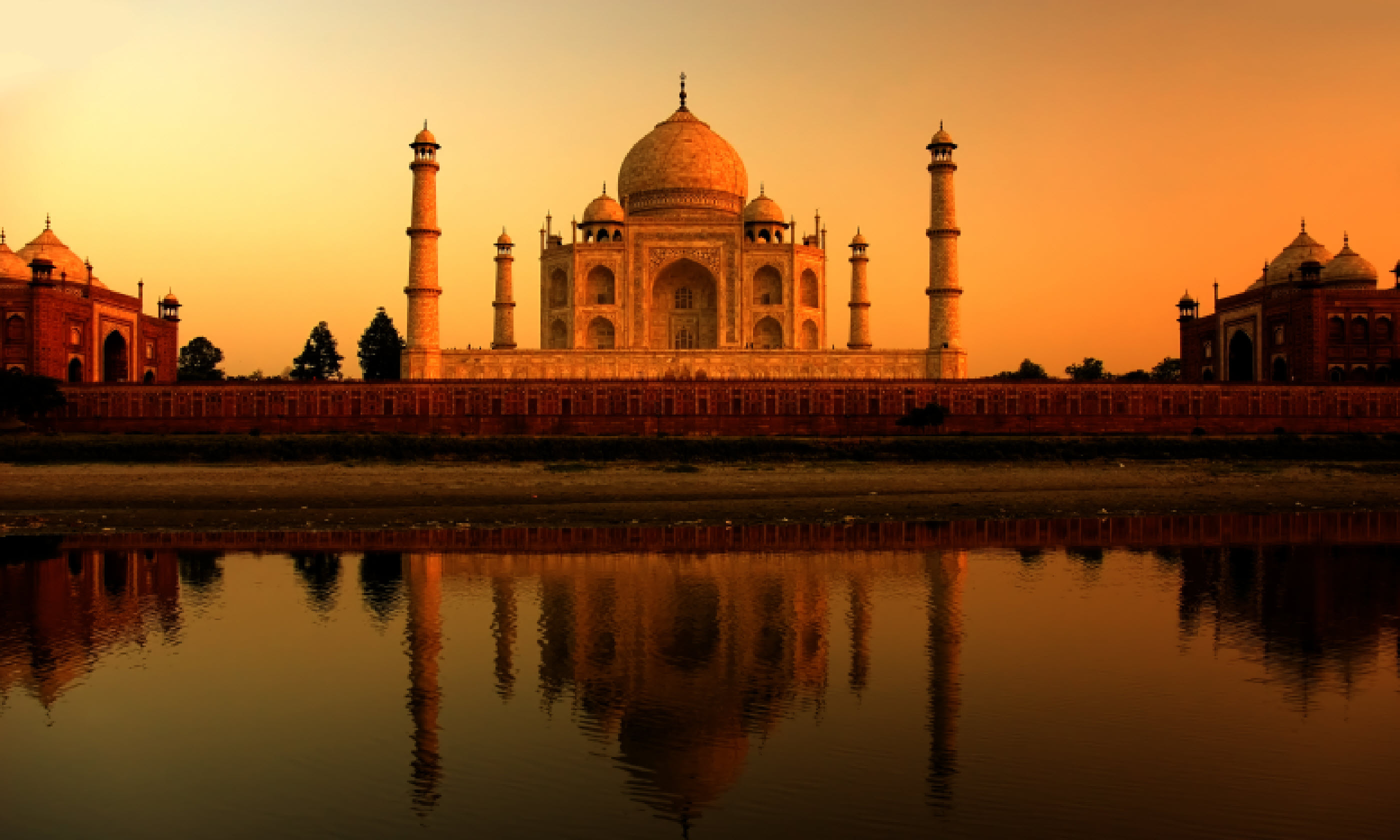
Yes, it's familiar, but the Taj – its graceful white curves, misty reflections, exquisite inlaid stone – does not disappoint. You’ll be fighting the crowds so make your first sight special: get to the gates for dawn, to be first in to watch as the mausoleum transforms from picture-on-a-poster to living, breathing 3D beauty under the rising sun.
Make it happen: The Taj is open daily from sunrise to sunset (closed Friday); entry costs Rs750 (£10).
Get more info on the Taj Mahal: Wanderlust's travel icon guide
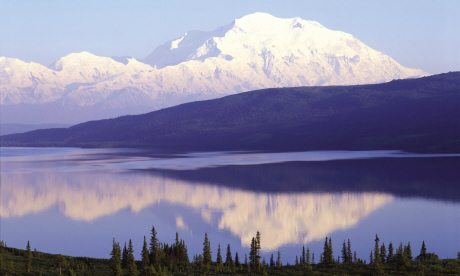 31. Plunge into the wilderness, Alaska, USA
31. Plunge into the wilderness, Alaska, USANorth America is renowned for dishing up huge portions, but it’s outdone itself with Alaska. The Last Frontier State is the USA’s biggest – but its least densely populated. It has 17 of the country’s 20 tallest mountains, topping out at the formidable 6,194m Mt McKinley, plus 70,000km of coastline, 300 rivers and around 100,000 glaciers.
Make it happen: May-August is the best time to visit; winters are long and cold, and snow can make some areas inaccessible.
Get more info on Alaska: Lyn Hughes practically cuddles brown bears | 5 things I wish I'd known before visiting Alaska | Alaska: the USA's wildest state
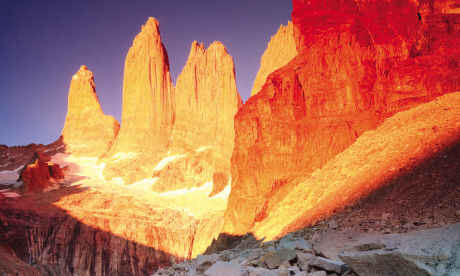 30. Glimpse Torres del Paine, Chile
30. Glimpse Torres del Paine, ChileThe sharp-shard peaks of Torres del Paine National Park, granite horns piercing the wilds of southern Chile, are fearsome. But there’s majesty and drama on a romantic scale in these mountains. Head to the lookout of Mirador Ferrier, via a winding beech-lined path from Lago Grey, for a panorama of the whole massif.
Make it happen: December to March are warmest; October to November are best for wildflowers. The Circuit hike takes 7-9 days, covering an average of 15-20km a day.
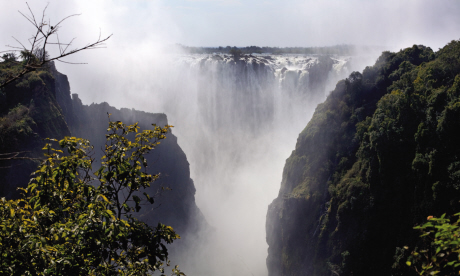 29. Feel the spray, Victoria Falls, Zambia/Zimbabwe
29. Feel the spray, Victoria Falls, Zambia/ZimbabweAs the Zambezi River encounters the 1,700m-wide edge of the Victoria Falls gorge on the Zambia/Zimbabwe border it tumbles 100m into the depths below. You'll fall head over heels for the world’s largest waterfall, as cascading torrents roar into deep pools, producing giant clouds of mist which glisten like diamonds in the African sun.
Make it happen: Victoria Falls’ water levels are highest April-June, but this is also the wet season; visit July-September for a good flow, but drier weather and better views.
Get more info on Victoria Falls: 7 ways to see the iconic waterfall
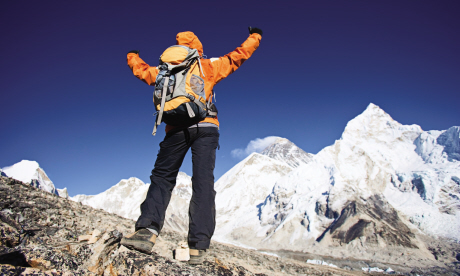 28. Get close to Mount Everest, Nepal
28. Get close to Mount Everest, NepalGiven that it’s the world’s highest mountain – an 8,848m behemoth – Everest is surprisingly accessible. Not its summit perhaps: tough training, 70 days and £30,000 are needed for that. But you can get intimate in other ways: 32km from Kathmandu, Nagarkot offers non-trekkers a breathtaking panorama, while short flights from the capital take you within touching distance.
Make it happen: The dry season (October-May) is best for clear skies. This is also peak trekking season. October-November are best; nights are cold December-February.
Get more info on Everest Base Camp: 5 tips for tackling Everest Base Camp | Everest Base Camp kit list | Wanderlust editor Phoebe Smith makes the climb
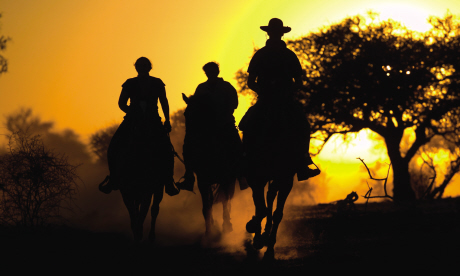 27. Go on a bush safari, Botswana
27. Go on a bush safari, BotswanaDesert, delta, forest, big skies: Botswana is the safari destination par excellence. Here, you can gallop on horseback alongside herds of zebra, sway on elephant-back above feeding antelope, or canoe the Selinda Spillway, currently full of water after being dry for 30 years.
Make it happen: Fly to Maun and pick up a safari, or cross the border from Zambia (having visited Victoria Falls en route), South Africa, Zimbabwe or Namibia.
Get more info on Botswana: Discover bushmen, baobabs and big wildlife with Graeme Green | Botswana's Central Kalahari is lion kingdom | Don't miss green season in Botswana's Okavango Delta
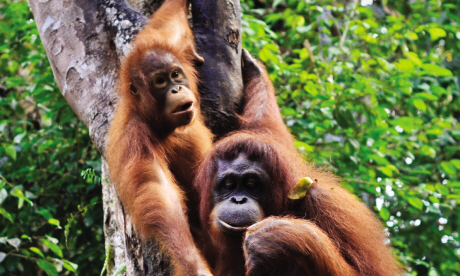 26. Watch wild orang utans, Borneo, Malaysia and Indonesia
26. Watch wild orang utans, Borneo, Malaysia and IndonesiaWaiting in anticipation on the forest floor, you scan the canopy above for a flash of orange. After listening to the guide’s orang utan calls, you suddenly lay eyes on these human-like creatures as they make their long-limbed way through the trees. Sanctuaries such as Sepilok and the Semenggoh Wildlife Rehabilitation Centre in Sarawak are the easiest places to get a good glimpse; in the forest you’ll need lots of luck.
Make it happen: Sepilok Orangutan Sanctuary is 23km from Sandakan; public buses run to within 1.5km of the sanctuary, or you can take a tour. Sepilok is open 8am-5pm; orang utans are fed twice daily, at 10am and 3pm.
Get more info on orang utans: Colourful characters on a trip to Sumatra
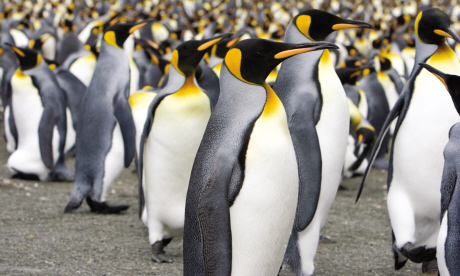 25. Sit among 100,000 king penguins, South Georgia
25. Sit among 100,000 king penguins, South GeorgiaThis spectacularly beautiful island is often summed up as being like Switzerland dropped into polar waters. You may have been told to keep 5m from the creatures, but they didn't attend the same briefing! Expect overload at Salisbury Plain, where 100,000 king penguins crowd the beach. At Gold Harbour, get close to the giant elephant seals.
Make it happen: Join an expedition cruise to Antarctica from Ushuaia (Argentina) that takes in South Georgia.
Get more info on South Georgia: Wanderlust's travel guide | How to get up close and personal with king penguins and elephant seals
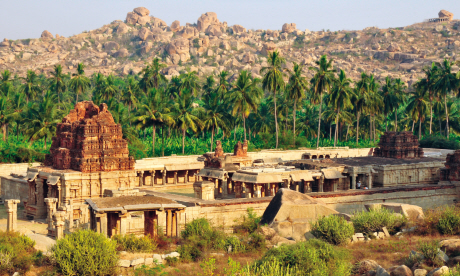 24. Roam the remains at Hampi, India
24. Roam the remains at Hampi, IndiaIn the state of Karnataka lies Hampi, capital of the once great Vijayanagara Empire. The city was destroyed in 1565, but even in its present state – a vast ruin among incongruously shaped boulders – the scale of the achievement still reverberates. Get here early, hire a bicycle, and marvel at a city that was said to rival Rome.
Make it happen: Bangalore (Bengaluru) is the closest major hub with direct flights from the UK. Take the Hampi Express night train to the ruins.
Get more info on Hampi: The ruins and their bloody history
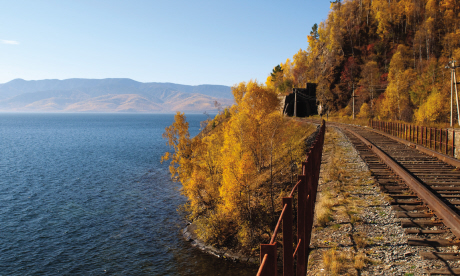 23. Ride the Trans-Siberian Railway, Russia
23. Ride the Trans-Siberian Railway, RussiaBeginning in European Russia, the railway rolls eastwards, through the Ural mountains and the vastness of Siberia, finally ending in the Russian Far East, on the shores of the Pacific Ocean. Or maybe not. Veer off after Lake Baikal and make for Mongolia or the north of China on the railway’s Trans-Mongolian and Trans-Manchurian offshoots.
Make it happen: Most travellers begin in Moscow due to ease of access. Trans-Siberian high season runs May-September.
Get more info on the Trans-Siberian: 10 stops on the Trans-Siberian | Wanderlust's travel guide to the Trans-Siberian | A guide to the ultimate train journey
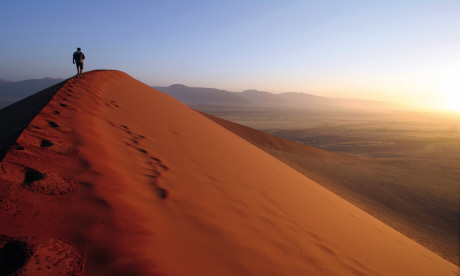 22. Delve into the dunes of Sossusvlei, Namibia
22. Delve into the dunes of Sossusvlei, NamibiaThere are sand dunes, and there are sand dunes. And the Namib Desert’s offerings in this arena are the Himalaya of the granular world: the dunes here tower up to 300m, massive undulations that shape-shift with the wind. They’re not just big, they’re beautiful – gracefully curved, rippled, and apricot-orange under a perennial blue sky.
Make it happen: Sossusvlei is 590km west of Windhoek. It’s accessible by 2WD; a 4WD is necessary for the final 5km to Sossusvlei Pan (or walk from the car park).
Get more info on Sossusvlei: Wanderlust blogger Marie Javins gets a bird's eye view
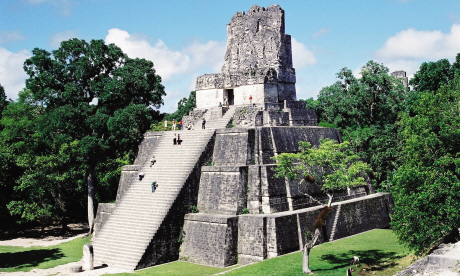 21. Marvel at the Mayan ruins of Tikal, Guatemala
21. Marvel at the Mayan ruins of Tikal, GuatemalaToday, deep in the tangled interior of the Petén Basin, it feels like time has stood still: climb the iconic Jaguar Temple and watch the sun set over the primordial jungle for an ancient overview. Just don’t leave your bag unattended: the local coatis, raccoon-type creatures, have light paws and a penchant for muesli bars.
Make it happen: Flores is the gateway town for Tikal, serviced by flights from Guatemala City. The Flores-Tikal minibus ride takes around 75 minutes. Tikal is open 6am-6pm; stay overnight so you can catch sunset and sunrise at the site.
Get more info on Mayan wonders: 4 ways to travel the Mayan route | Explore El Mirador, Guatemala's lost city
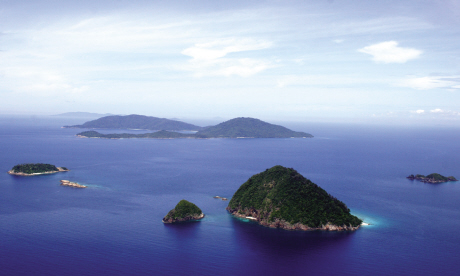 20. Lounge on islands, Malaysia
20. Lounge on islands, MalaysiaThese coral-fringed islands offer lush forest scenery, unspoiled white beaches and plentiful opportunities for scuba diving in their pristine turquoise waters. Get hands-on with turtle conservation projects or stretch your legs on a trek through inland jungle brimming with wildlife (including exotic birds, monkeys and giant monitor lizards).
Make it happen: The Perhentian Islands can be accessed by boat from Kuala Besut, 110km north of Kuala Terengganu. Ferries to Tioman run from Mersing.
Get more info on Maylasia: Wanderlust's travel guide
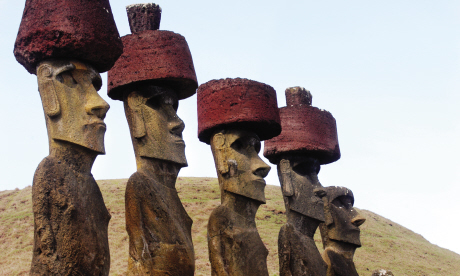 19. Meet moai, Easter Island, Chile
19. Meet moai, Easter Island, ChilePolynesians first arrived on the isolated outcrop of Easter Island around AD 300. And here they stayed, unbothered by anyone, until Europeans arrived in the 18th century. In that time, they got creative, constructing nearly 900 stone moai. Believed to represent ancient ancestors, many of these spirits continue to watch over the island today.
Make it happen: Easter Island is 3,800km west of mainland Chile. Flights from Santiago take around five hours; onward flights to Tahiti are around five hours.
Get more info on Easter Island: Wanderlust's travel guide | How to do Easter Island on the cheap
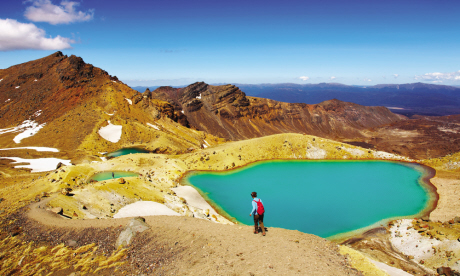 18. Hike the Tongariro Crossing, New Zealand
18. Hike the Tongariro Crossing, New ZealandIt’s touted as New Zealand’s – if not the world’s – best day walk. It’s a manageable challenge – at six to eight hours it will test but not break you. Then there’s the variety: from the shrubby Mangatepopo Valley, to the lunar Red Crater, the sulphurous sparkles of Blue and Emerald Lakes and, finally, the descent into lush forest.
Make it happen: The Crossing starts from Mangatepopo Roadend, 6km off Highway 47; it finishes at Ketetahi Roadend. Local operators can arrange transfers.
Get more info on the Tongariro Crossing: Is this still the best day walk in the world?
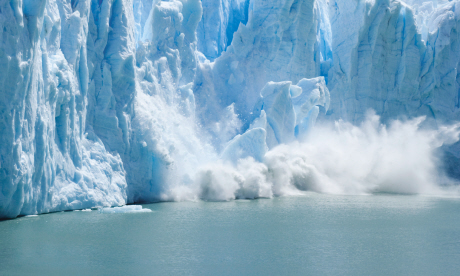 17. Listen to the creak of the Perito Moreno Glacier, Argentina
17. Listen to the creak of the Perito Moreno Glacier, ArgentinaSail up to Perito Moreno's terminus to appreciate its scale: the white-blue cliff is up to 70m high, creakingly advancing into Lake Argentino. Keep a safe distance: every now and then the glacier heaves, and huge chunks calve off into the water below.
Make it happen: Los Glaciares NP is 78km from El Calafate, accessible by car or bus. Boat tours can be taken from Puerto Bandera;
Get more info on Perito Moreno Glacier: Wanderlust's travel icon guide
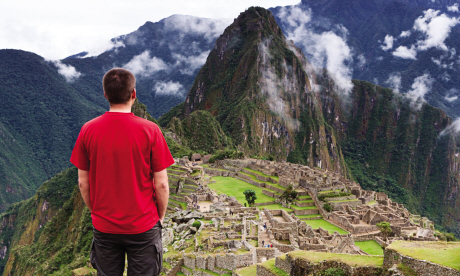 16. Trek to Machu Picchu, Peru
16. Trek to Machu Picchu, PeruHow did they do that? How did those 15th-century Inca architects construct a city of mortarless stone, 2,500m up in the Andes? This is engineering of the tallest order, in the most dramatic of settings – one so remote even the conquistadores couldn’t find it. Today, access is a little easier – but the views and the achievement no less impressive.
Make it happen: The classic 43km Inca Trail hike from Km88 to Machu Picchu takes 3-4 days; permits are necessary – independent trekking is not allowed.
Get more info on Machu Picchu: Know before you go: Peru | 10 things you may not know about Machu Picchu | Wanderlust's Machu Picchu travel guide
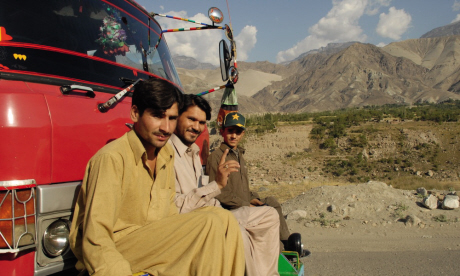 15. Travel the Karakoram Highway, Pakistan
15. Travel the Karakoram Highway, PakistanThis is the stuff of travel legend. The route wriggles from north of Islamabad to Kashgar in China, and there are plenty of adventures on the way: you’ll drink tea with polo players, see peaks soaring over 7,000m and spot ancient rock art by the roadside. You’ll be whiplashed, bruised and exhausted. You’ll have the time of your life.
Make it happen: UK nationals require a visa to enter Pakistan.
Get more info on the Karakoram Highway: Discover welcoming people and jaw-dropping scenery
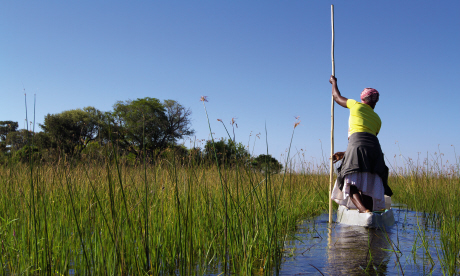 14. Take a mokoro through the Okavango Delta, Botswana
14. Take a mokoro through the Okavango Delta, BotswanaTraditionally carved from a tree trunk, the mokoro was the common means of transport of the Bavei tribe. Today, fibreglass is increasingly common, rather than wood, but these canoes are still the best ways to explore the channels and waterways of the largest delta in the world.
Make it happen: Maun is the gateway into the region. Pick up a safari there, or pre-book with a specialist.
Get more info on Botswana: Discover bushmen, baobabs and big wildlife | Botswana's Central Kalahari is lion kingdom | Green season in Botswana's Okavango Delta
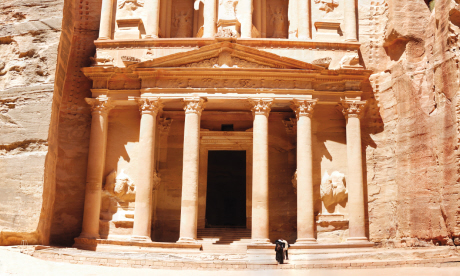
Deep in the Jordanian desert, hemmed in by sandstone crags and approached along a slither of a canyon, suddenly an ancient facade looms out of the rock. And not a weathered outline: a crisply-defined colossus, six mighty pillars guarding the entrance as if the Nabateans (who built them two millennia ago) had just popped out for lunch.
Make it happen: Allow two days (or more). See our Petra travel guide for more information.
Get more info on Petra: How to take great photographs at Petra | Ultimate top 5 guide: Petra and Wadi Rum | The complete guide to Petra
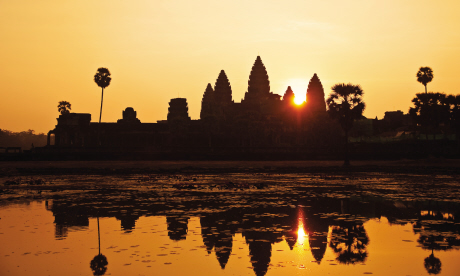 12. Take in sunrise over Angkor Wat, Cambodia
12. Take in sunrise over Angkor Wat, CambodiaIt’s the combination of beauty and scale that provides the wow factor for this temple, the principal monument in a complex that includes Hindu and Buddhist temples in their hundreds. Arrive early to catch the sunrise and miss the crowds, and make the most of that famous view from across the moat, where Angkor Wat is reflected in the water.
Make it happen: Siem Reap is the hub town for Angkor, served by flights from cities including Bangkok and Hanoi.
Get more info on Angkor: Angkor Wat by bike | Angkor Wat: temple by temple | Alternative 'sunset' finder developed for Angkor
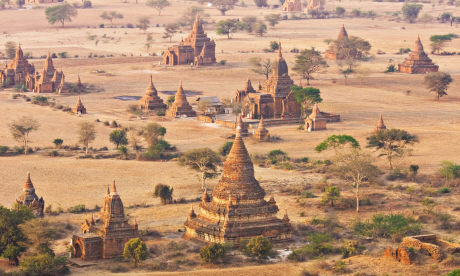 11. Visit the temples of Bagan, Burma
11. Visit the temples of Bagan, BurmaIt’s the sheer scale that astounds: the remains of 2,217 ancient stone temples, scattered across a vast, barren, copper-coloured plain. From the 11th to 13th centuries this 41 sq km complex was the biggest religious and cultural centre in the world. Now dusty and abandoned, what is left is best toured by bicycle or by horse and cart.
Make it happen: Bagan is 140km south-west of Mandalay.
Get more info on Bagan: Burma's top 3 bike rides | Martin Symington discovers the real Burma | 5 things I wish I'd known before visiting Burma
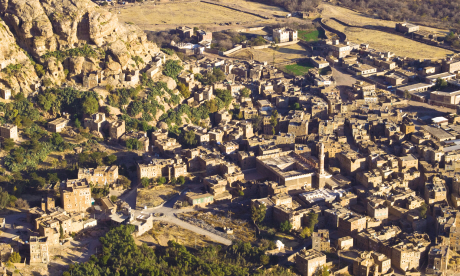 10. Venture to Shibam, Yemen
10. Venture to Shibam, Yemen “As you approach Shibam by plane, you get spectacular views of the mud-brick towns of the Hadhramaut built high into the rugged flat-topped mountains. Shibam dates from the fourth century and all the houses – which rise up to nine storeys – are made from mud-brick, with decorated doors and windows.” – Jane Baxter, Wanderlust reader
Make it happen: Yemen is currently off-limits: the Foreign Office advises against all travel to the whole of the country.
 Get your hands on our new 100 Greatest Travel Experiences book: free with every 2016 Christmas gift subscription to Wanderlust! The perfect gift for travel lovers – and you can even keep the book if you wish (We won't tell!) Sign up here
Get your hands on our new 100 Greatest Travel Experiences book: free with every 2016 Christmas gift subscription to Wanderlust! The perfect gift for travel lovers – and you can even keep the book if you wish (We won't tell!) Sign up here
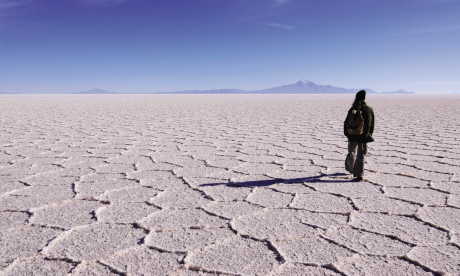 9. Cross the Salar de Uyuni salt flats, Bolivia
9. Cross the Salar de Uyuni salt flats, BoliviaIn the dry season these vast expanses appear as an endless patchwork of hexagonal shapes, white as the Arctic; in the rainy season (December to April) the area becomes a 9,000 sq km mirror, giving the sensation of travelling across the sky. Drive out over the plains in a jeep and stay in a hotel made out of salt – beds, chairs, tables, the lot.
Make it happen: The hub-town of Uyuni is a seven-hour bus ride from Potosí; 12-15 hours by bus from La Paz. The seven-hour train ride from Oruro is a scenic option.
Get more info on Bolivia: 5 reasons to get friendly with Bolivia | Bolivia's 10 unmissable street foods | Bolivia's best landscapes
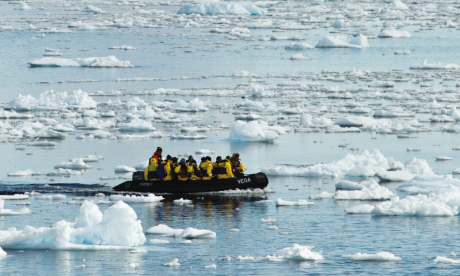 8. Appreciate all that ice, Antarctica
8. Appreciate all that ice, Antarctica The notorious sail to Antarctica across the Drake Passage can be a tough one, but that is swiftly forgotten as you start to see more and more ‘bergy bits’. Of course, the wildlife is a reason to go to Antarctica too: the various penguins steal your heart while sightings of whales, leopard seals and snowy shearwaters will make any trip memorable.
Make it happen: Expedition cruises leave from Ushuaia (Argentina), Christchurch (NZ) and Hobart (Tasmania).
Get more info on Antarctica: 3 unmissable Antarctica trips | 7 ways to get there
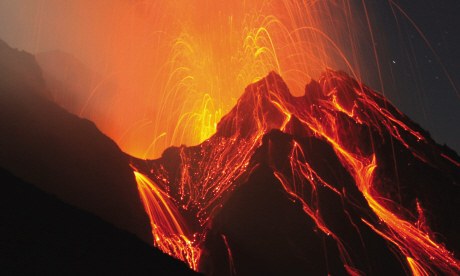 7. Sit on the summit of Stromboli, Italy
7. Sit on the summit of Stromboli, ItalyThe climb up takes two to three hours, moving through fig trees, oleander and broom at the base to sparse shrubs further up and finally nothing but black volcanic rock. If you set off in the afternoon, you reach the summit at dusk. Hard-hat on, you spend an hour ooh-ing and ahh-ing as magma bubbles through the volcano’s vents.
Make it happen: Stromboli is a four-hour ferry or 1.5-hour hydrofoil journey from the Aeolian Island of Lipari. There is no airport.
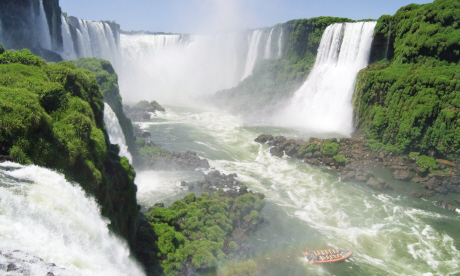 6. Ogle Iguaçu Falls, Argentina/Brazil
6. Ogle Iguaçu Falls, Argentina/BrazilA fine force of nature straddling the border between Argentina and Brazil, this chasm is one of the widest waterfalls in the world, consisting of 275 cascades spread in a horseshoe shape over 3km. Make the journey on foot and let your anticipation build with the growing roar before emerging to soak up the spray on a walkway or boat ride.
Make it happen: Puerto Iguazú, Argentina, is a 90-minute flight from Buenos Aires. Buses run to the visitor centre; from here, walk or take a quick train ride to the falls.
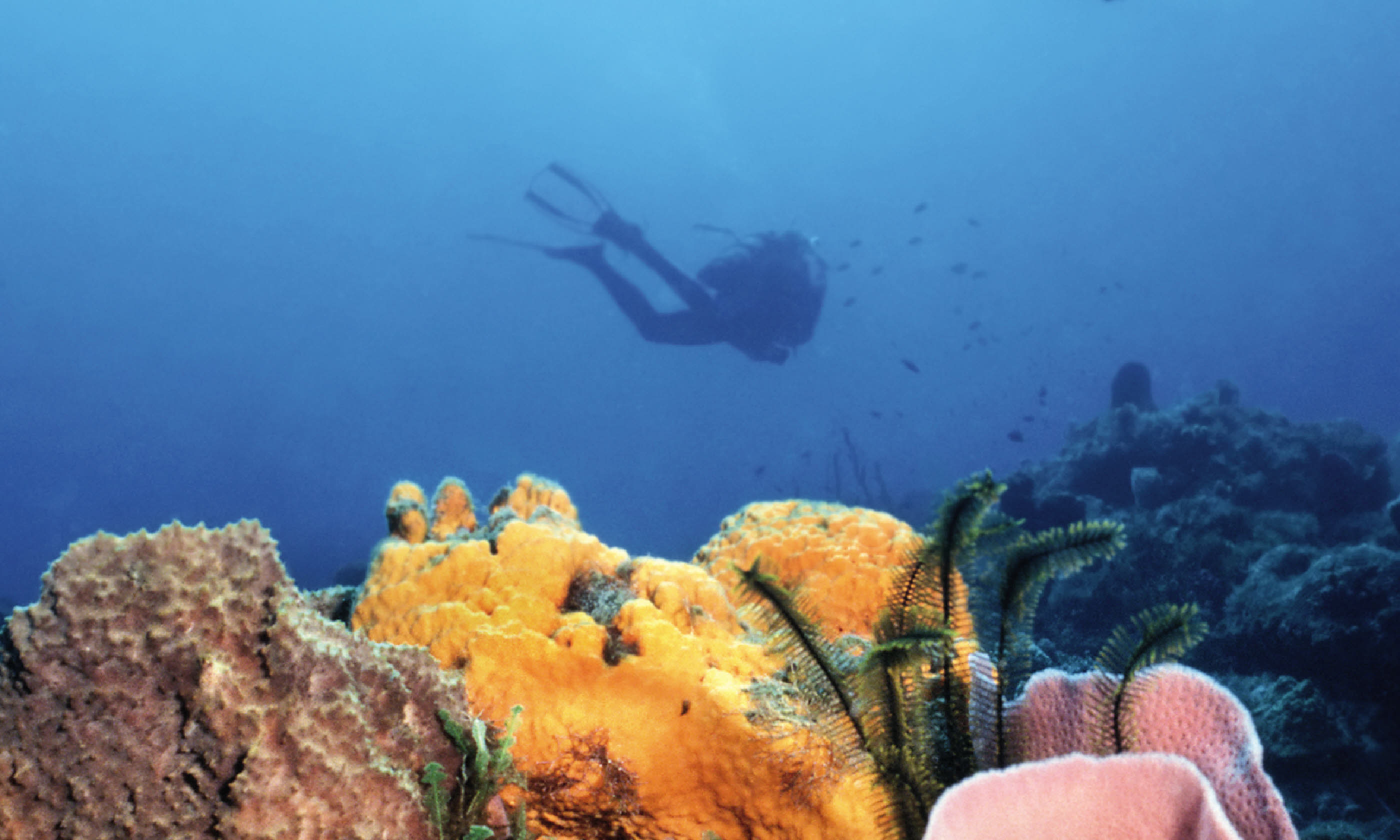
There’s no need to don your diving gear: just bring a mask and snorkel, immerse yourself in the shallow lagoon and wait for a graceful giant to glide silently by. While you are exploring this underwater garden, don’t be surprised if you bump into a bat, leopard or eagle ray – the waters here host some of the most diverse marine life on earth.
Make it happen: Bora Bora is 250km north-west of Tahiti. Daily flights from Tahiti’s Faa’a airport take 45 minutes; some stop at the islands of Moorea, Huahine and Raiatea.
Get more info on French Polynesia: Don't miss these four trip itineraries
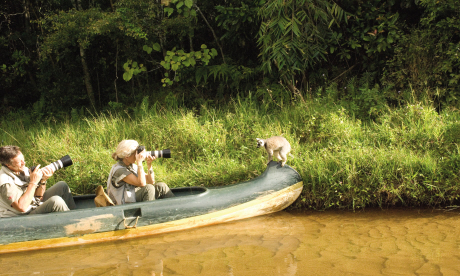 4. Learn about the lemurs, Madagascar
4. Learn about the lemurs, MadagascarMadagascar is the oldest island on earth, and its flora and fauna have evolved in isolation over tens of millions of years. Madagascar developed lemurs, a gentle primate. There are 86 different species recognised, ranging from mouse lemurs up to the indri, the size of a chimpanzee. A stunning 90% of Madagascar’s flora and fauna is endemic.
Make it happen: Fly to capital Antananarivo (known as Tana). Apr/May and Oct/Nov are the best times to visit.
Get more info on Madagascar: Explore the wild west limestone forest | In search of the incredible (and ugly!) aye-aye
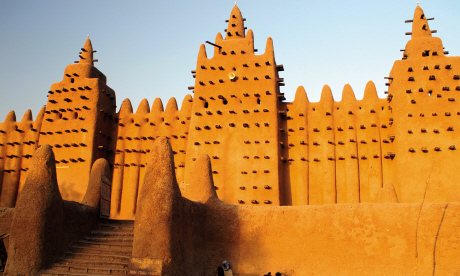 3. Arrive in Timbuktu, Mali
3. Arrive in Timbuktu, MaliThe small, dusty town of Timbuktu has long been a byword for isolation. Visit the bustling market, where salt was once worth as much as gold, and then cool down with sweet tea as you barter for silver with the Tuareg nomads. Come sunset, venture out into the desert by camel, and drift to sleep under a million stars.
Make it happen: The FCO currently advises against travel to Timbuktu. If you choose to go, you can fly from Bamako to Timbuktu airport, or take a Niger River trip.
Get more info on Timbuktu: Sail the River Niger to Timbuktu | Take a taxi to Timbuktu
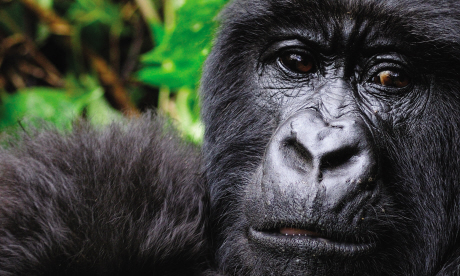 2. Meet mountain gorillas, Rwanda/Uganda
2. Meet mountain gorillas, Rwanda/Uganda“Imagine our surprise when we came upon the family of gorillas all sleeping peacefully with only the silverback on watch. We sat enchanted at their feet and, after a while, they started to wake and stretch just like a human family in the morning. He was unperturbed by our presence and we felt privileged to be visiting.” – Alan Wood, Wanderlust reader
Make it happen: For Rwanda, fly to Kigali. For Uganda, fly to Entebbe, near Kampala. In both countries, gorilla-trekking permits cost from US$500.
Get more info on gorillas: 10 best places for gorilla watching | Which gorilla is which? | How to spend one perfect hour with Uganda's gorillas
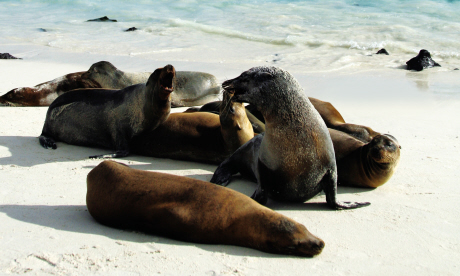 1. Cruise the Galápagos Islands, Ecuador
1. Cruise the Galápagos Islands, EcuadorOne day you’re watching giant tortoises mate in swirling mists, the next you’re nose to nose with a seafaring lizard, the next you’re snorkelling with a group of penguins… on the equator. And, as Darwin came to appreciate, neighbouring islands have sub-species that have developed differently, leading to one of the most important, world-changing discoveries ever known: evolution. Scientifically, scenically and sensorially spectacular.
Make it happen: The best way to explore is by boat. Although three or four night cruises are available, try to go for a week at least.
Get more info on the Galapagos Islands: Wanderlust's travel guide | There's change afoot on the archipelago
 Get your hands on our new 100 Greatest Travel Experiences book: free with every 2016 Christmas gift subscription to Wanderlust! The perfect gift for travel lovers – and you can even keep the book if you wish (We won't tell!) Sign up here
Get your hands on our new 100 Greatest Travel Experiences book: free with every 2016 Christmas gift subscription to Wanderlust! The perfect gift for travel lovers – and you can even keep the book if you wish (We won't tell!) Sign up here

